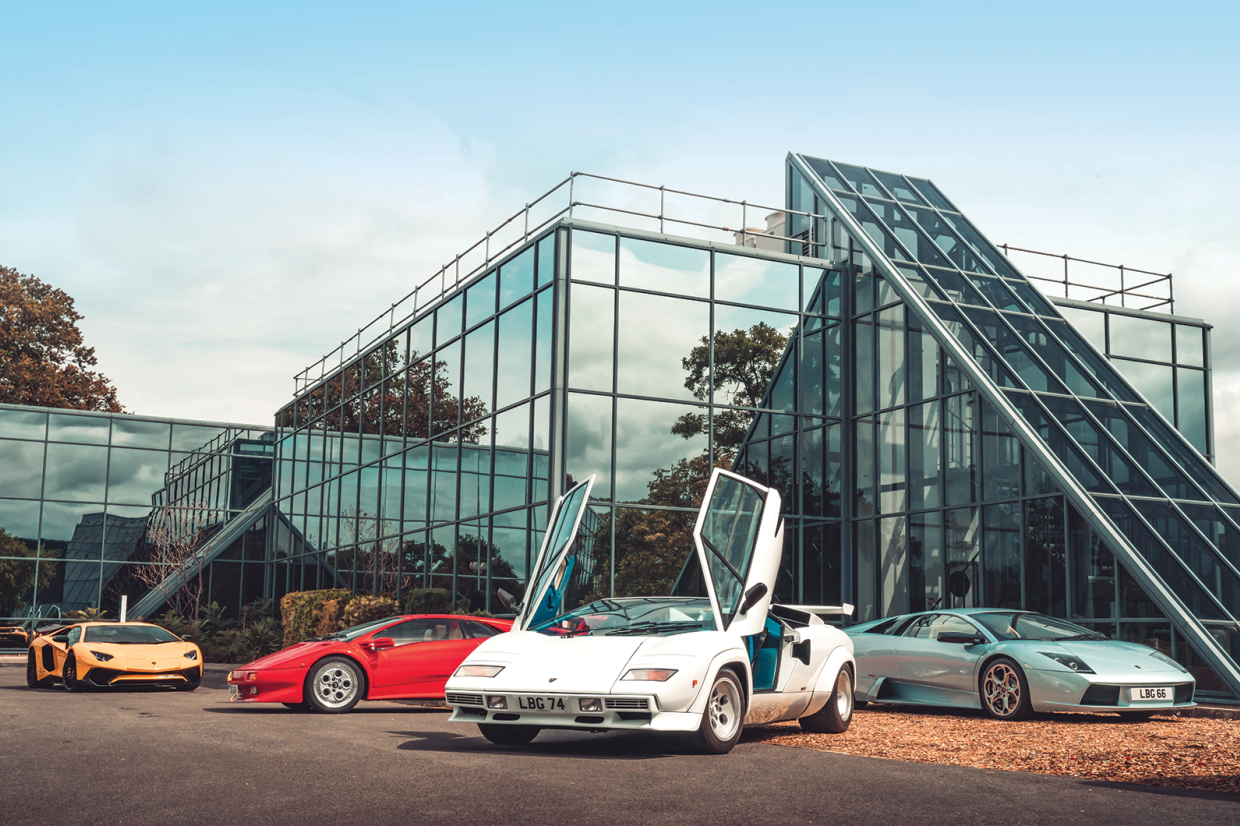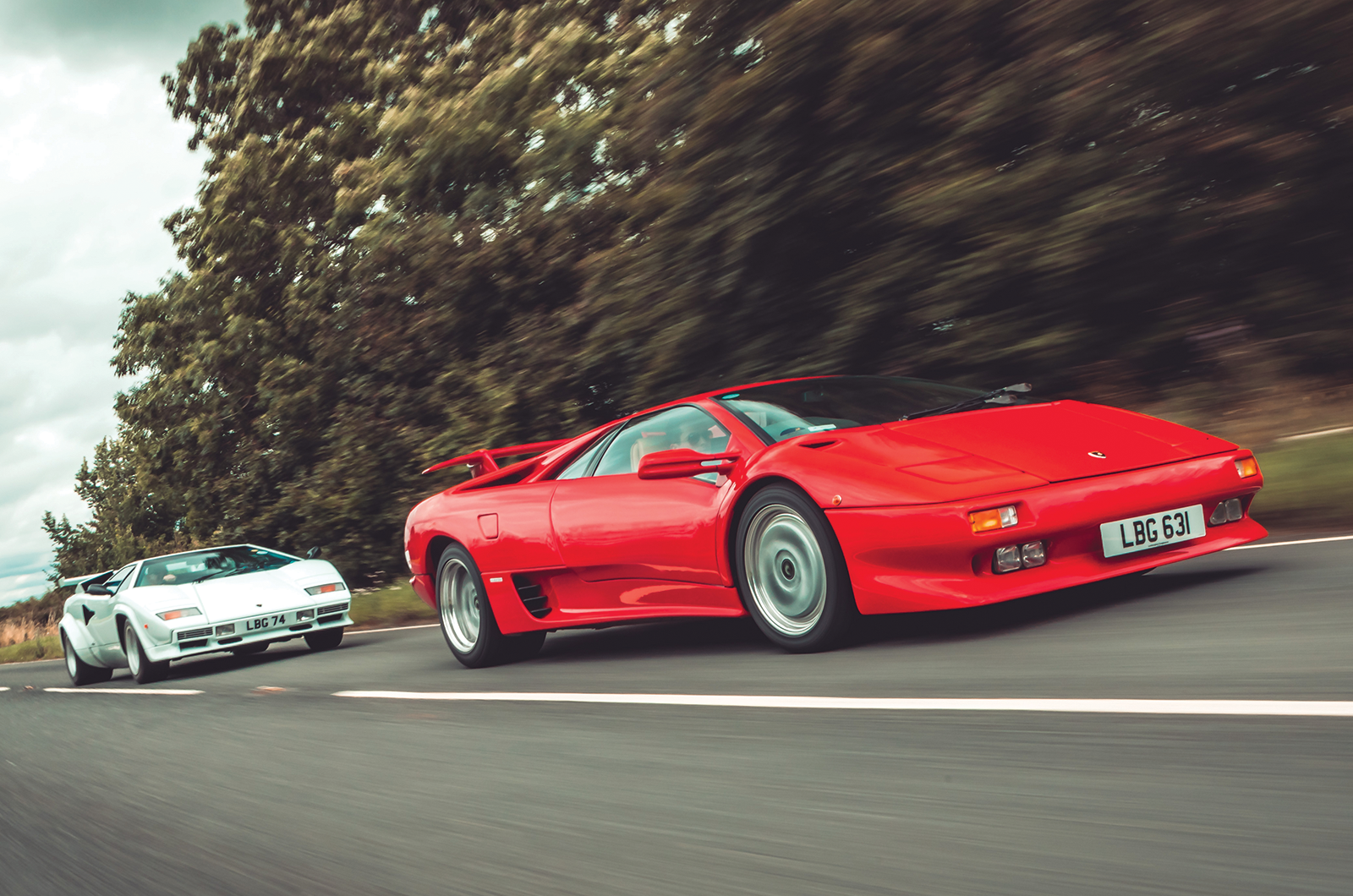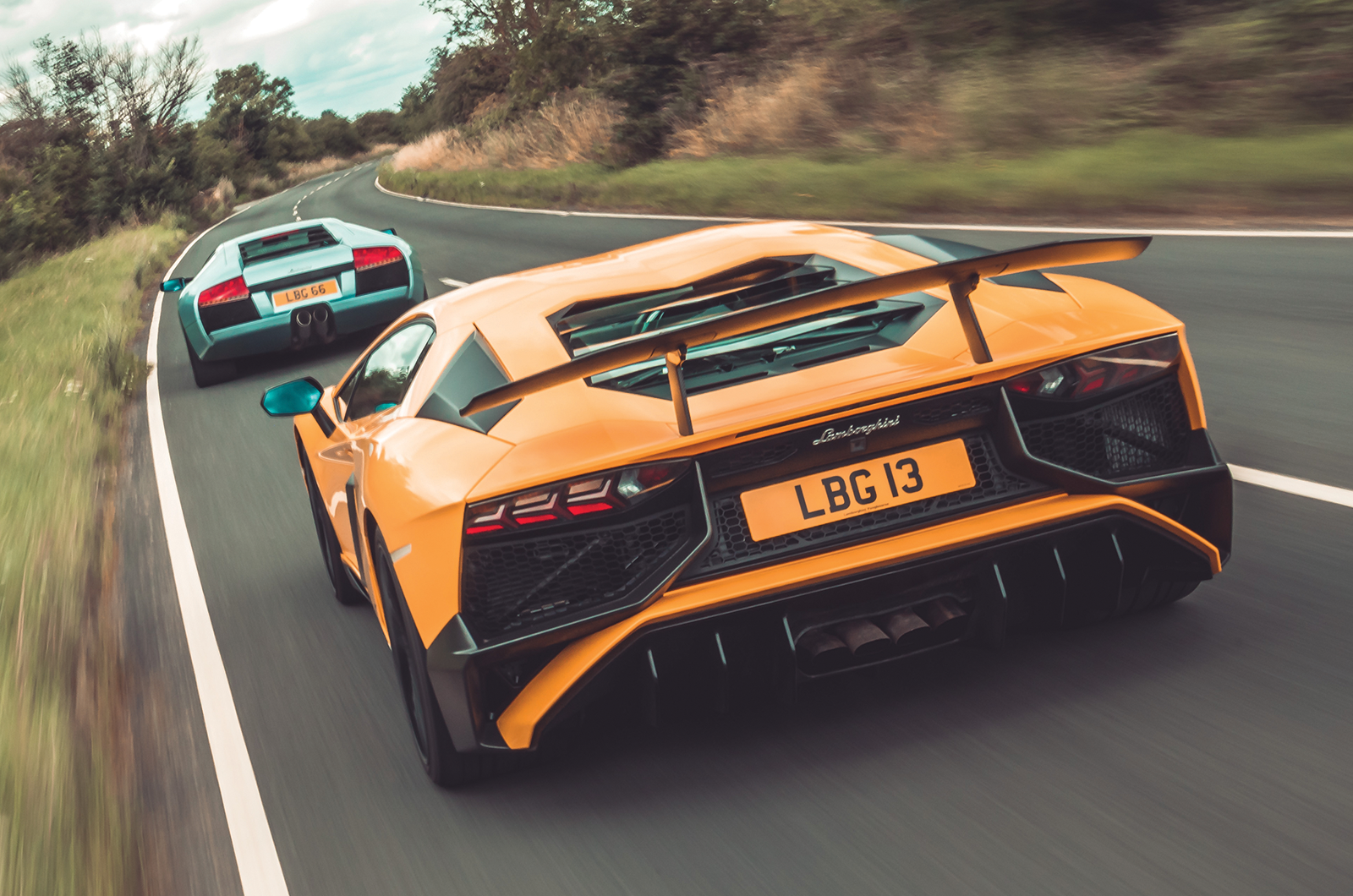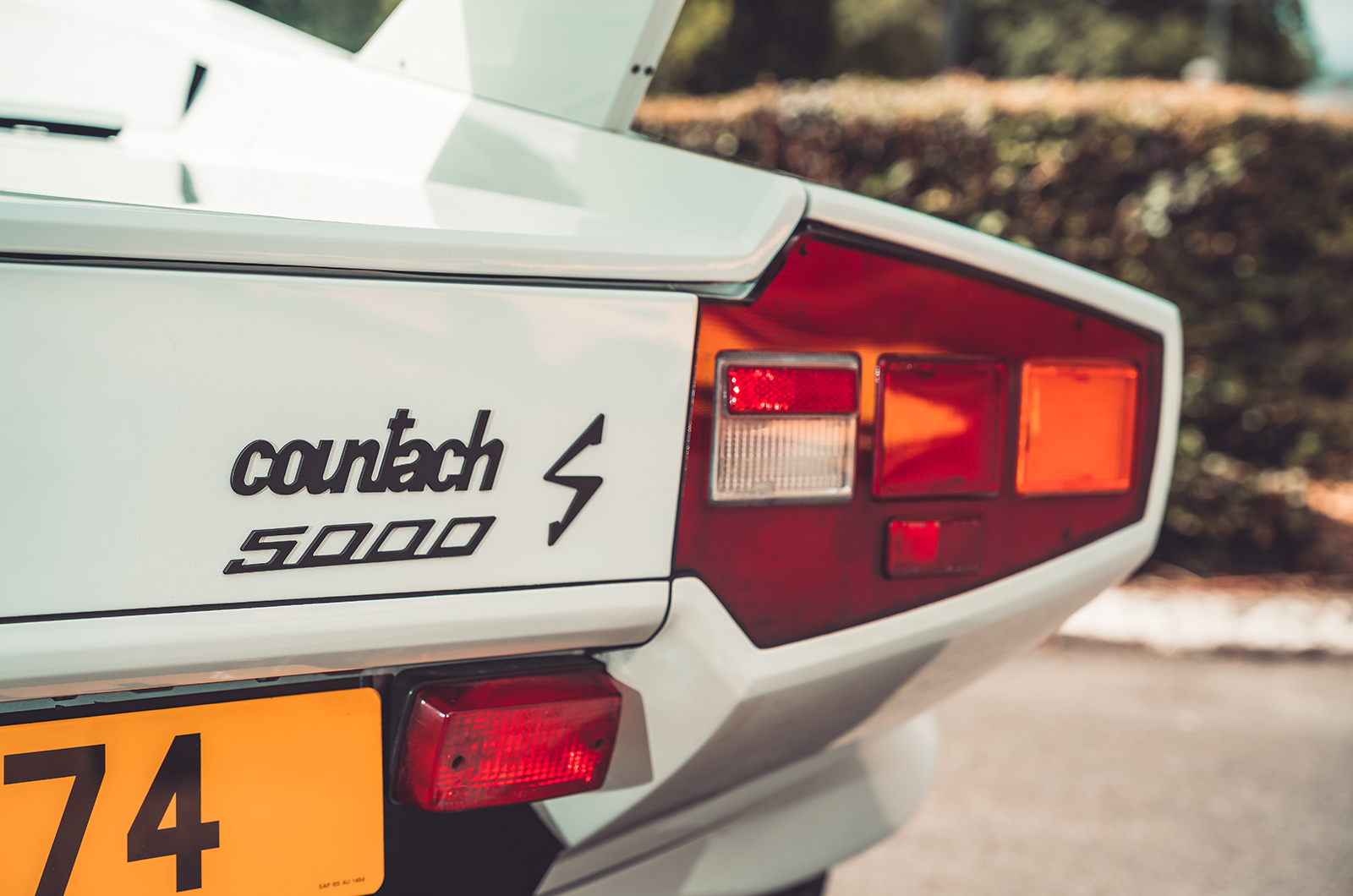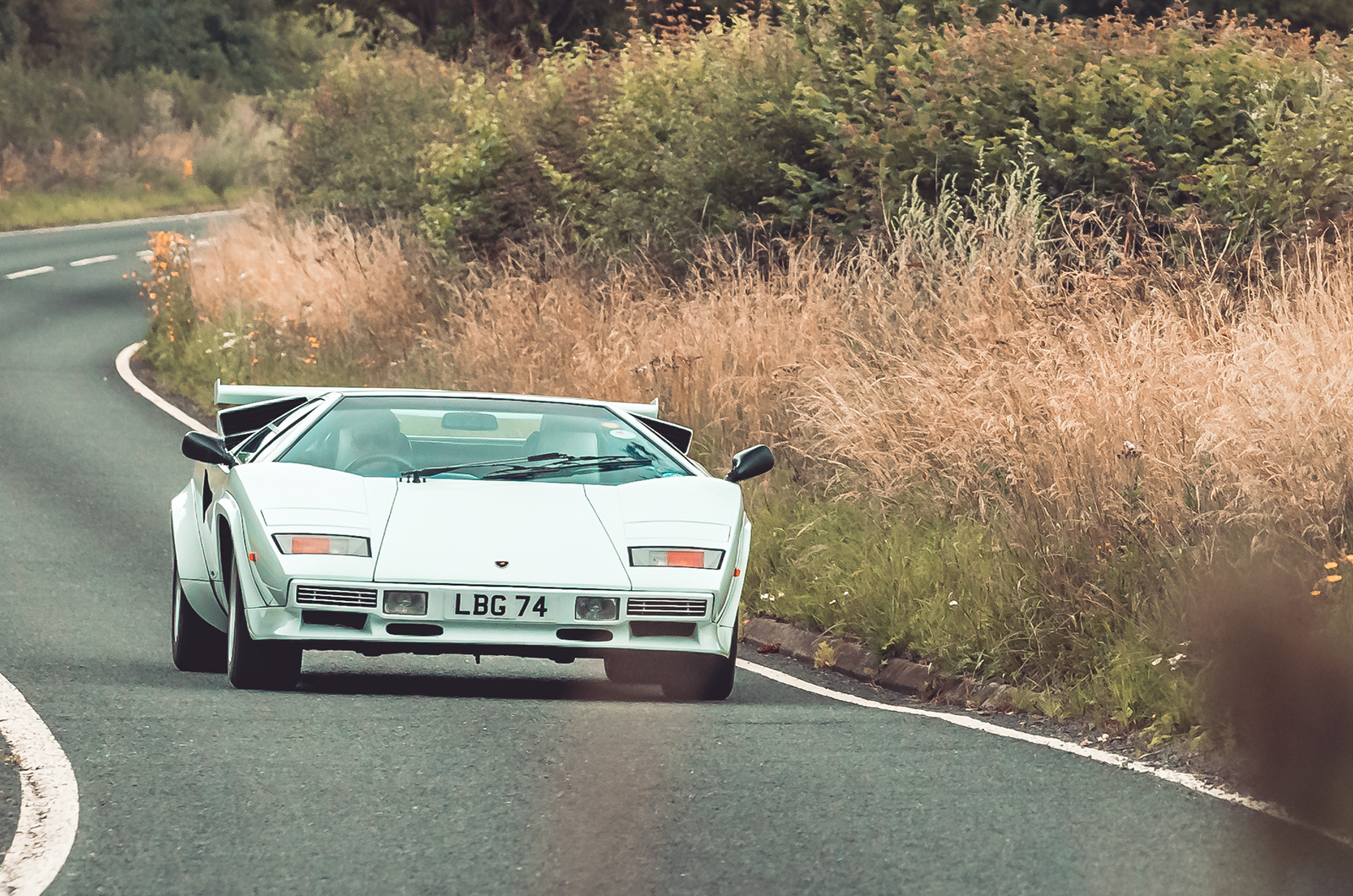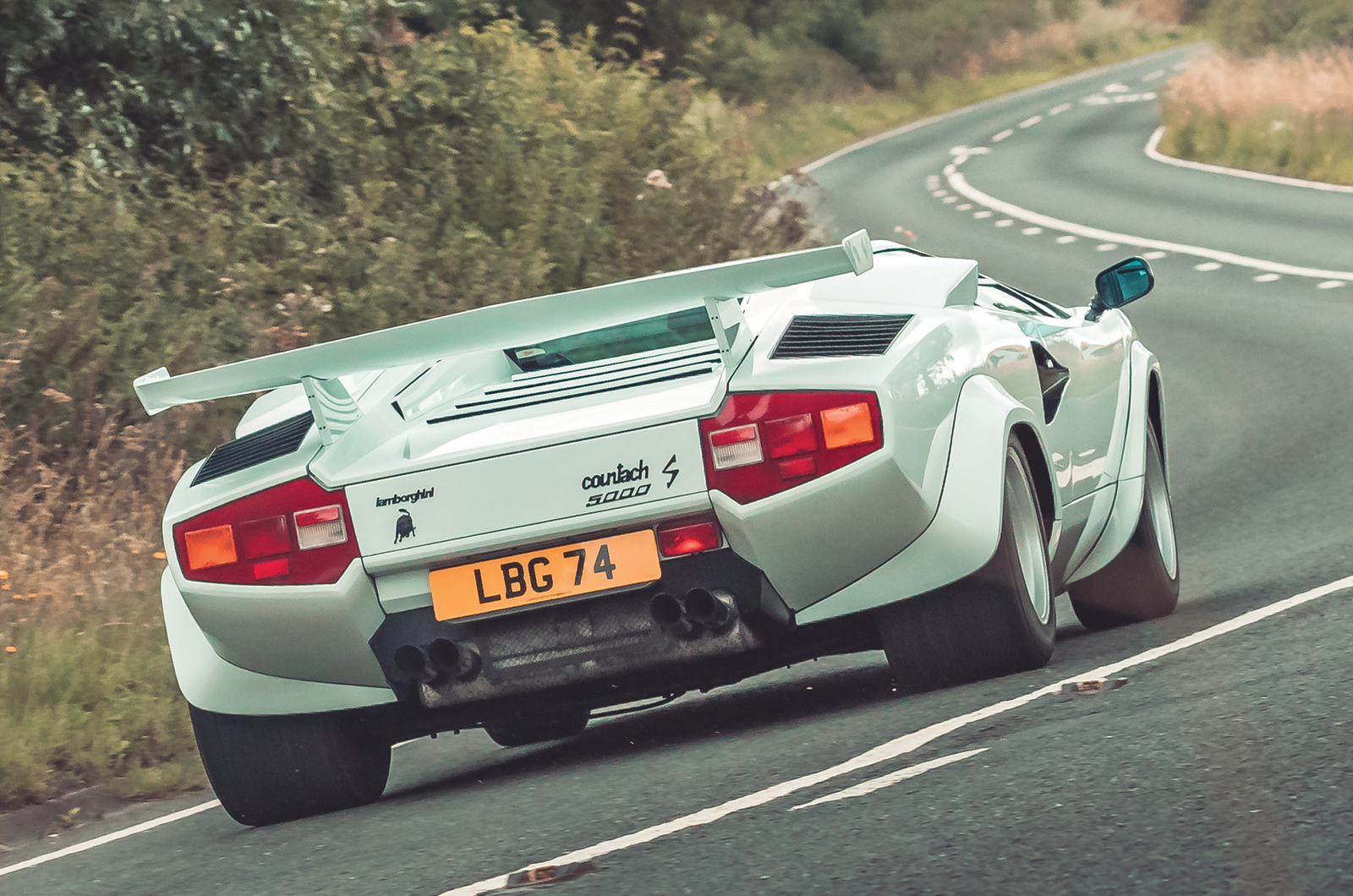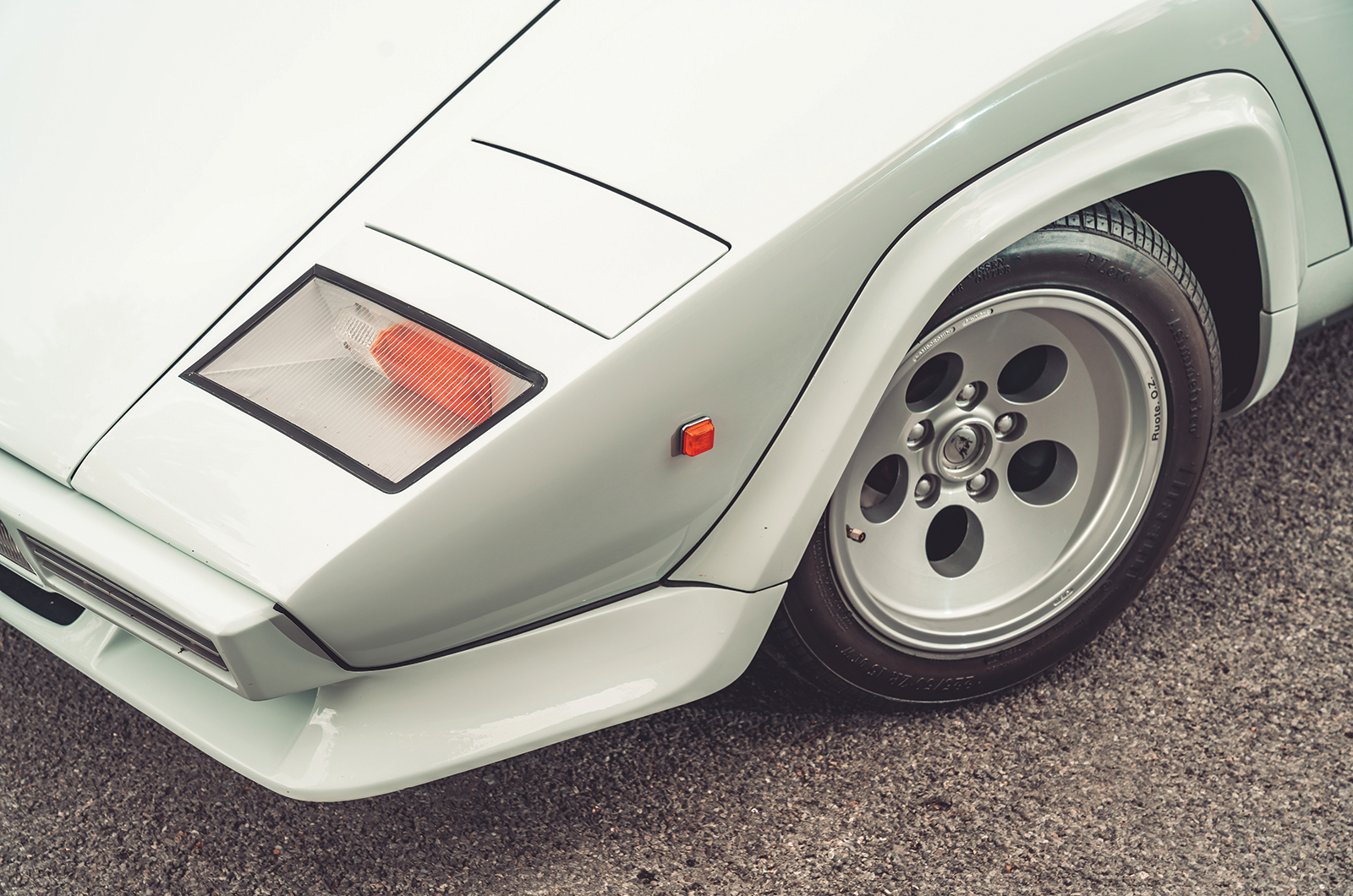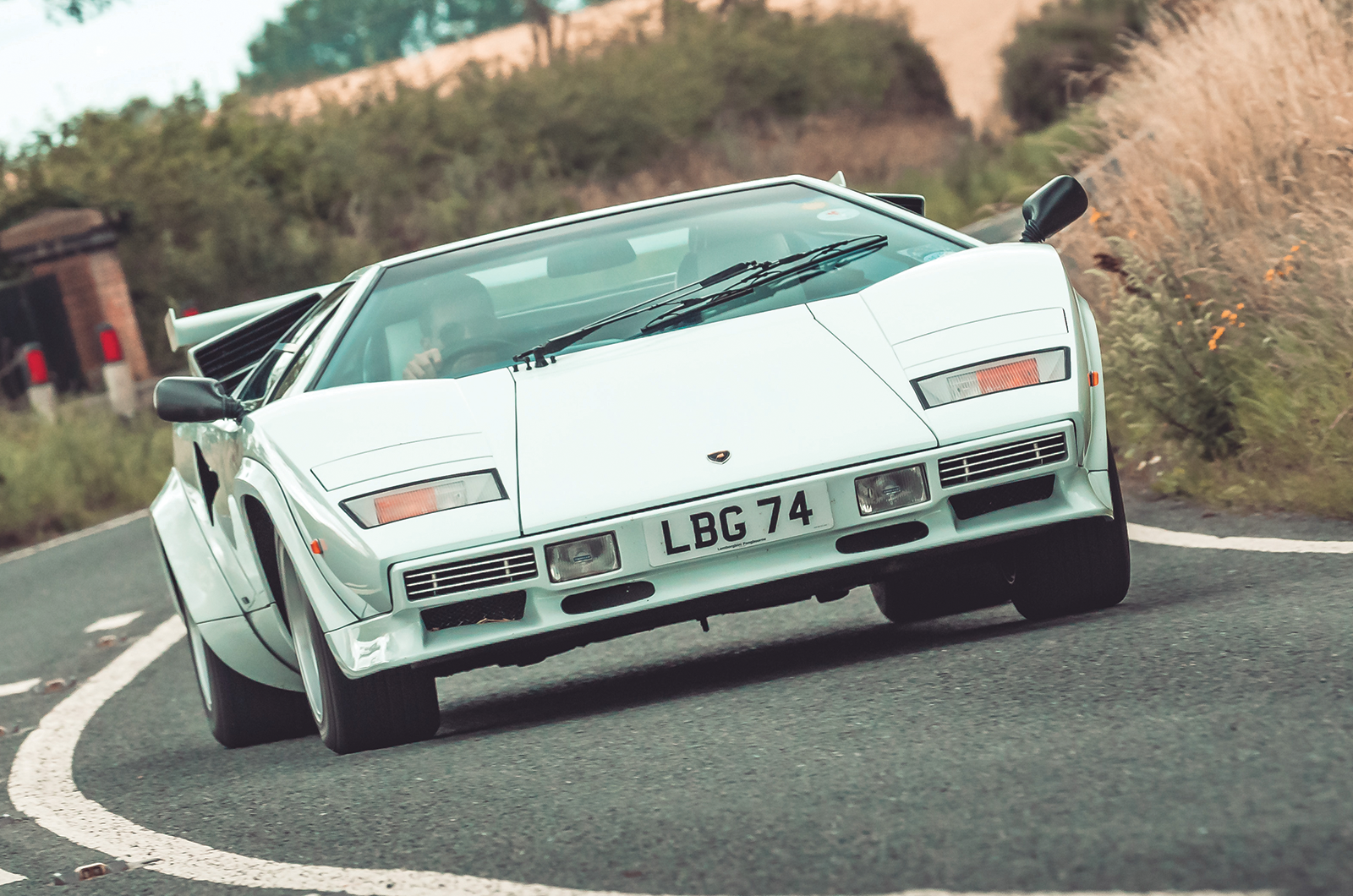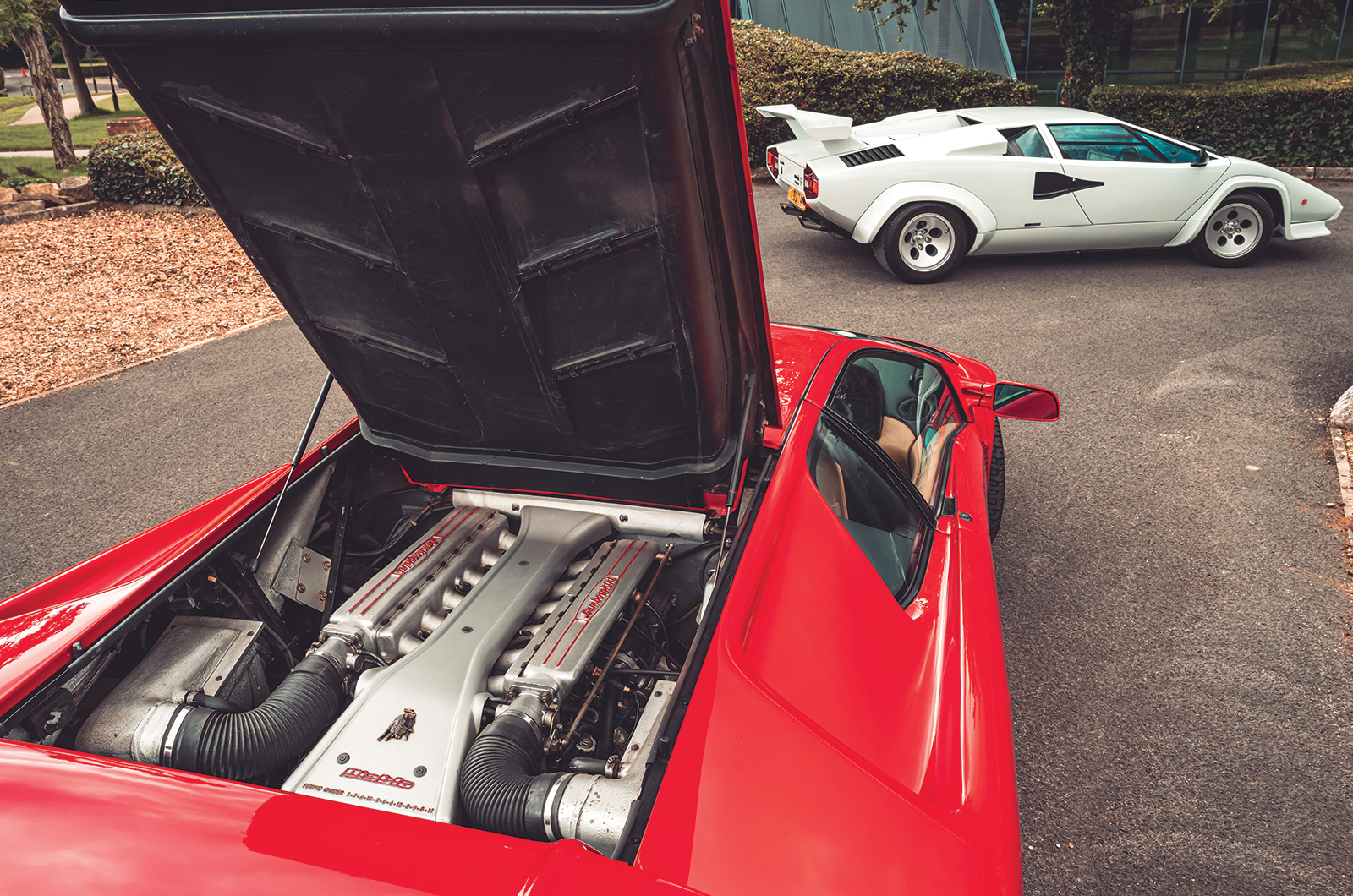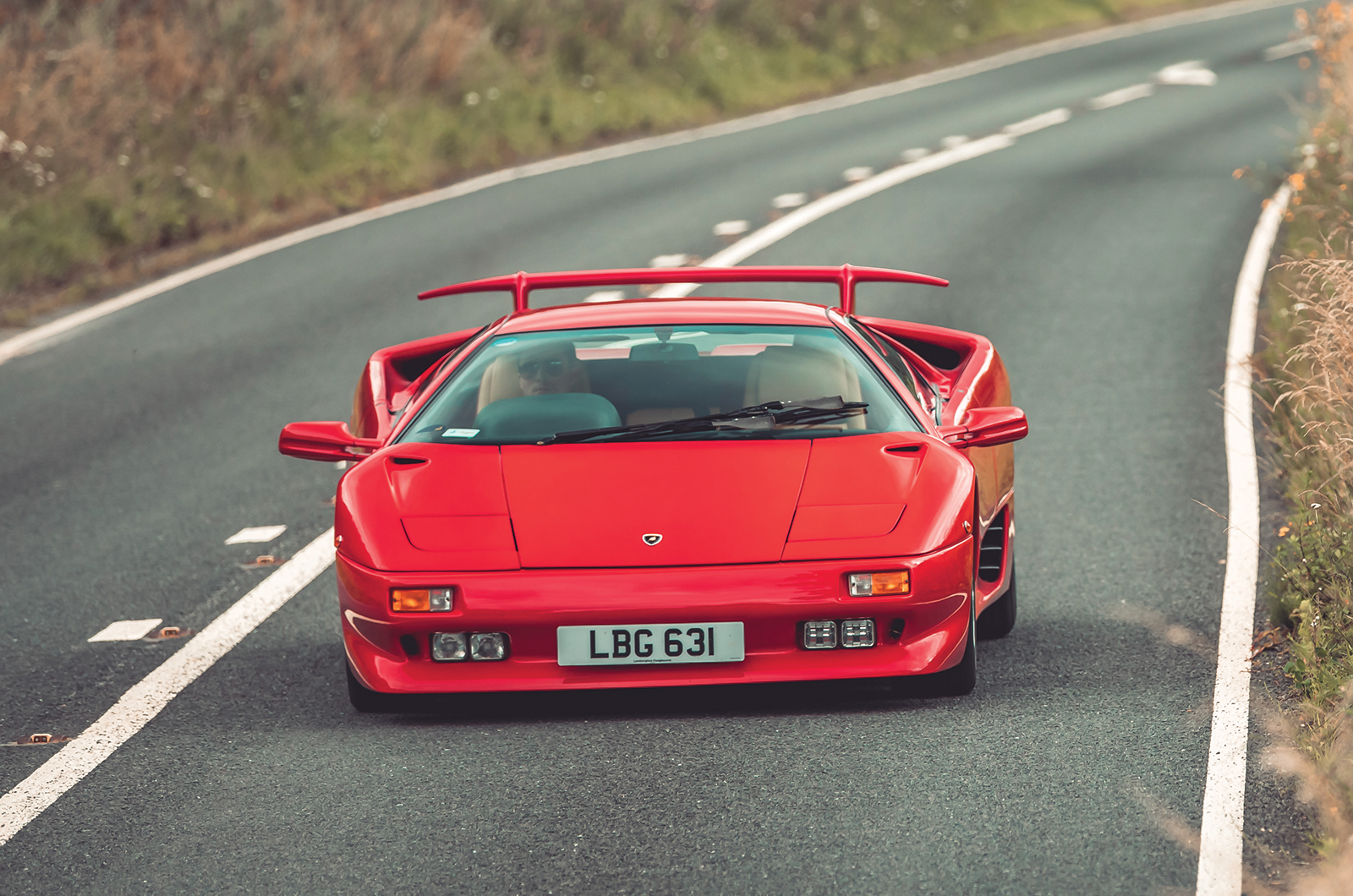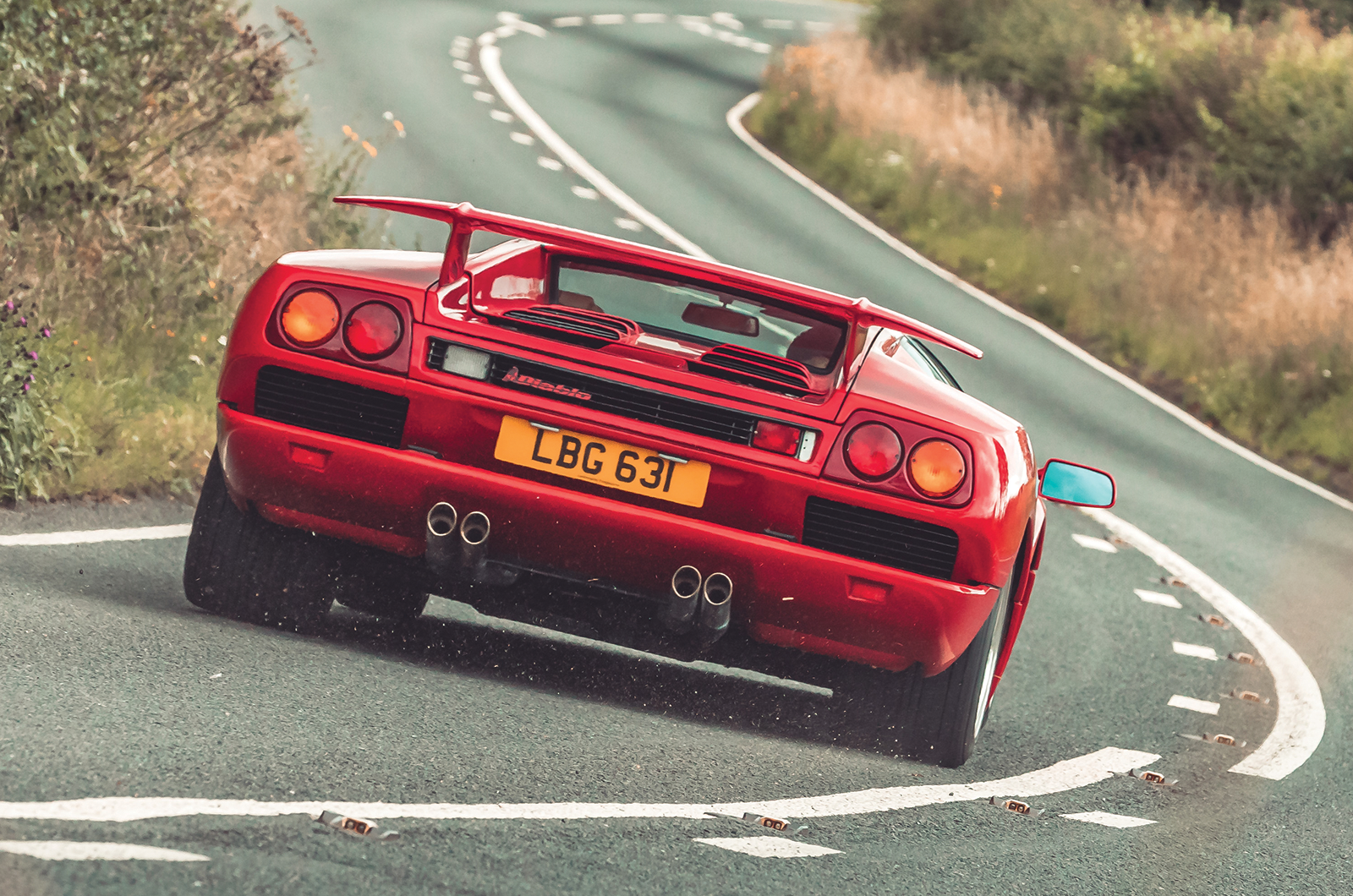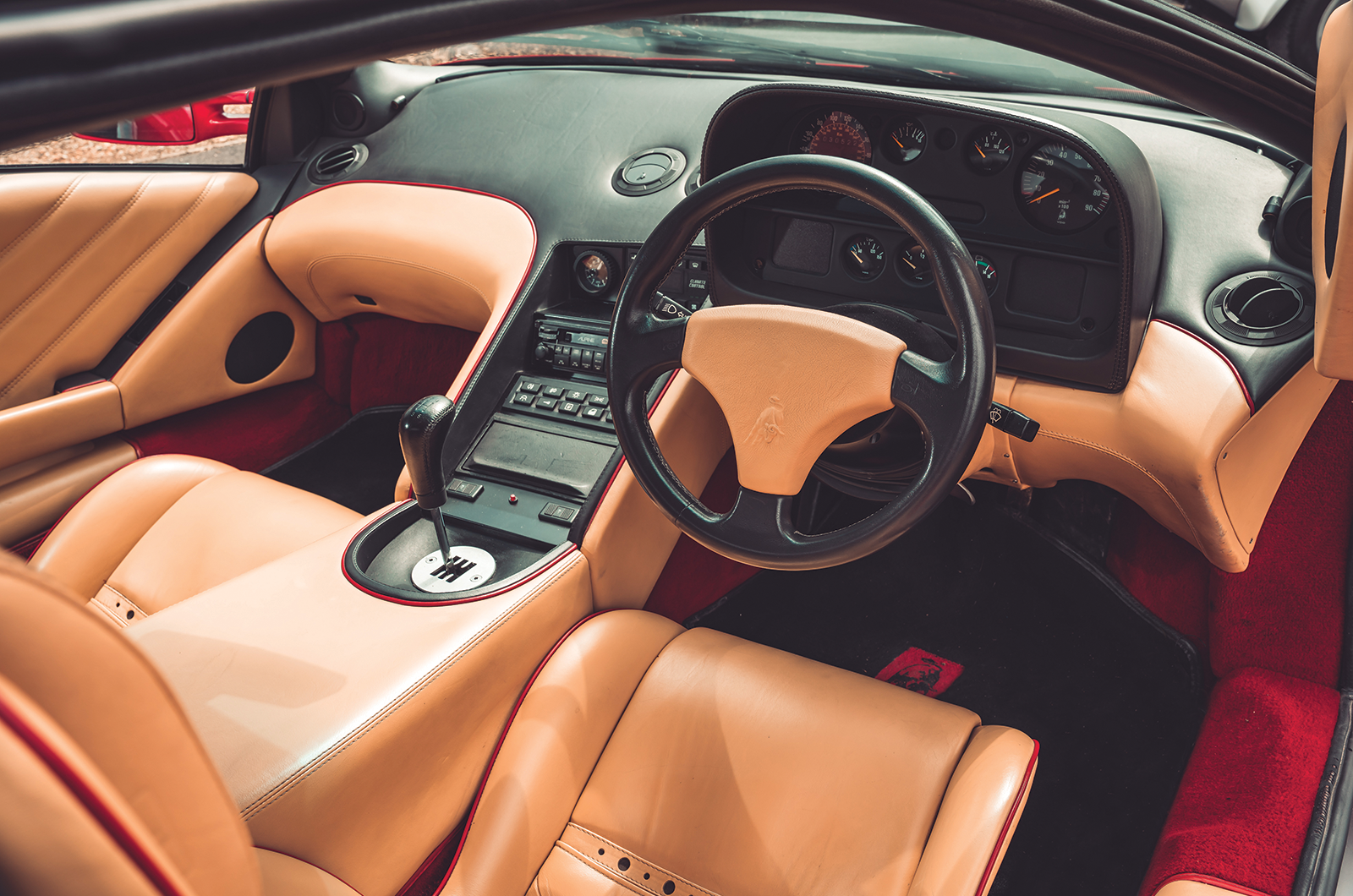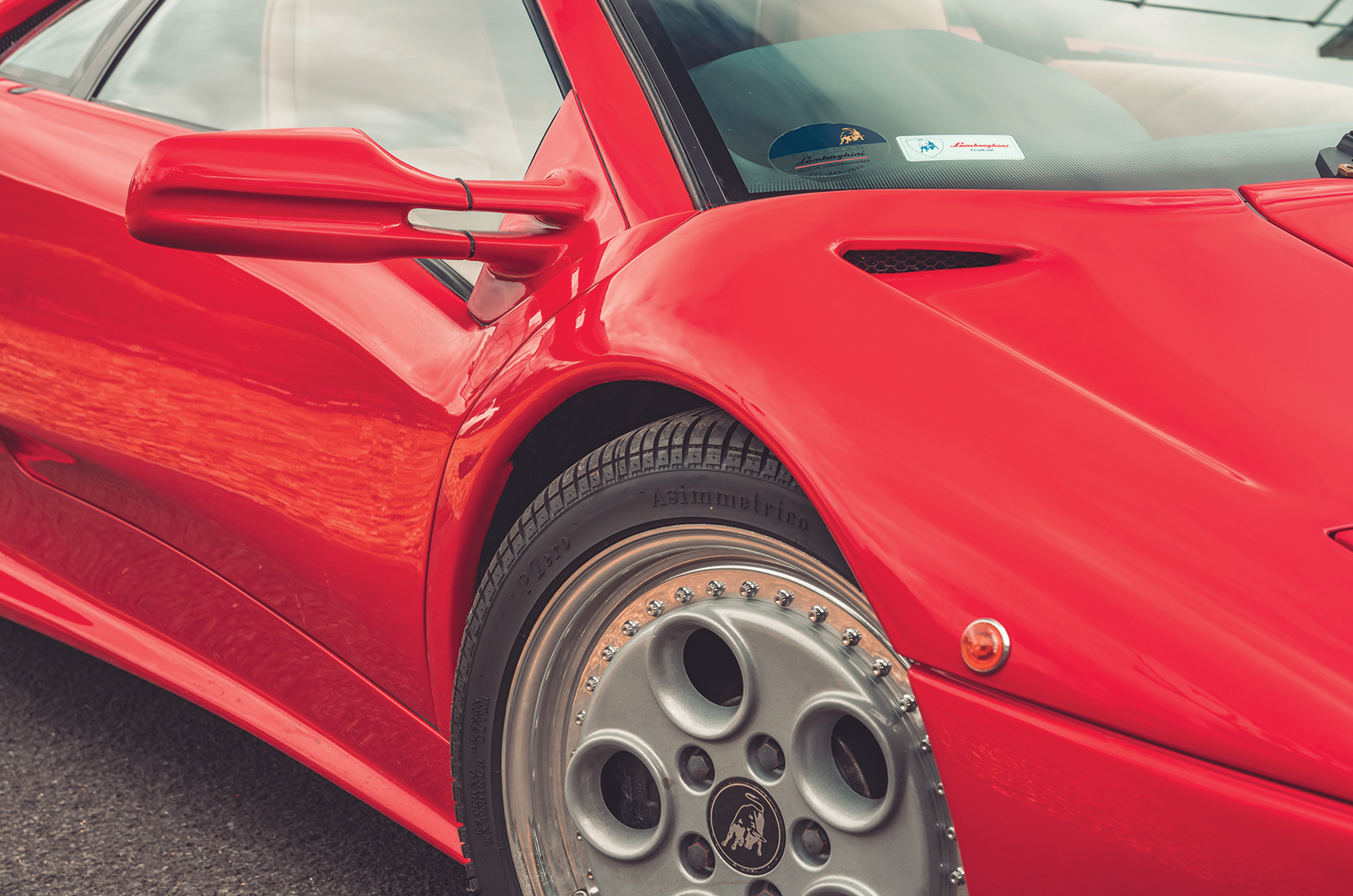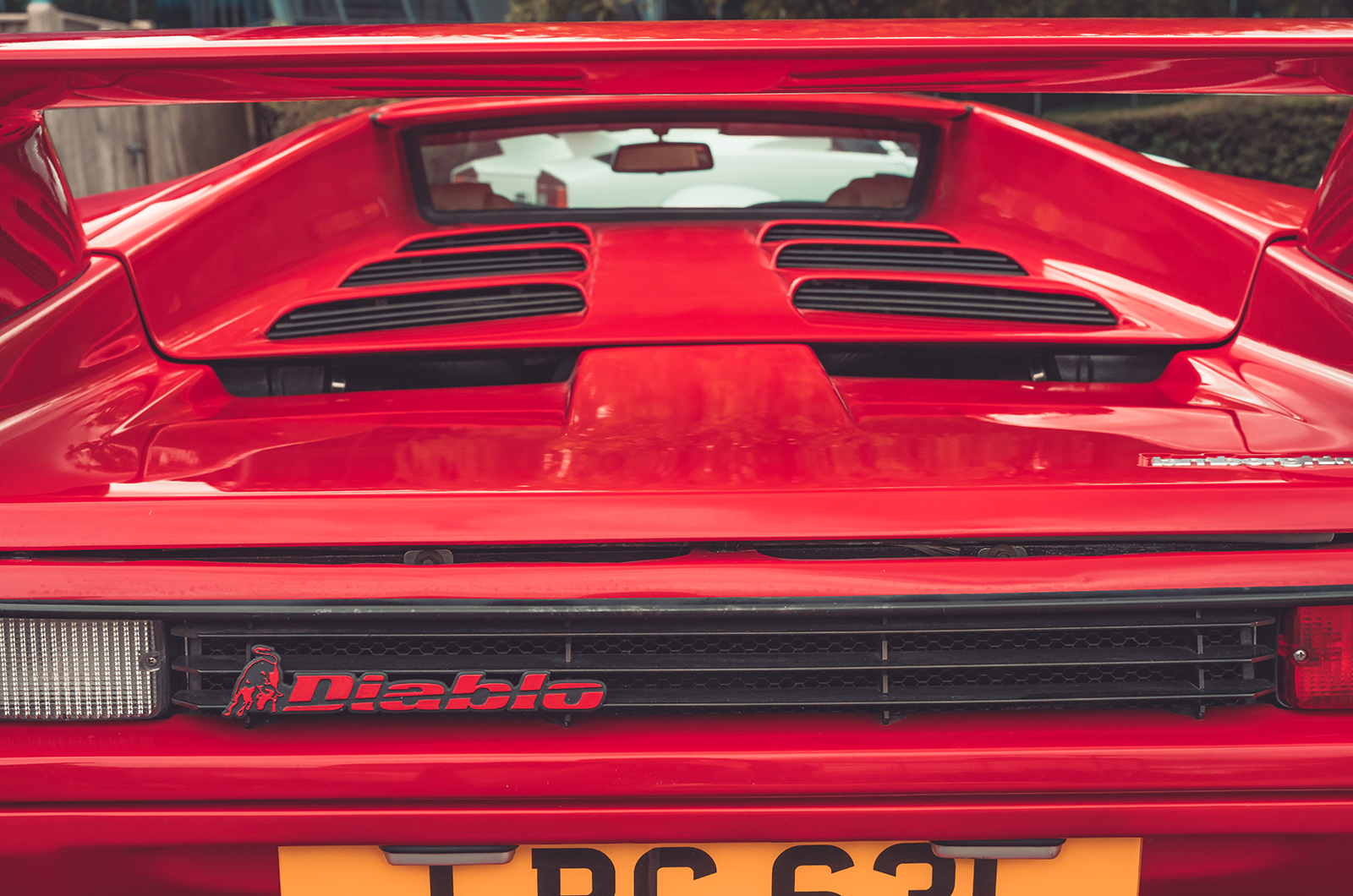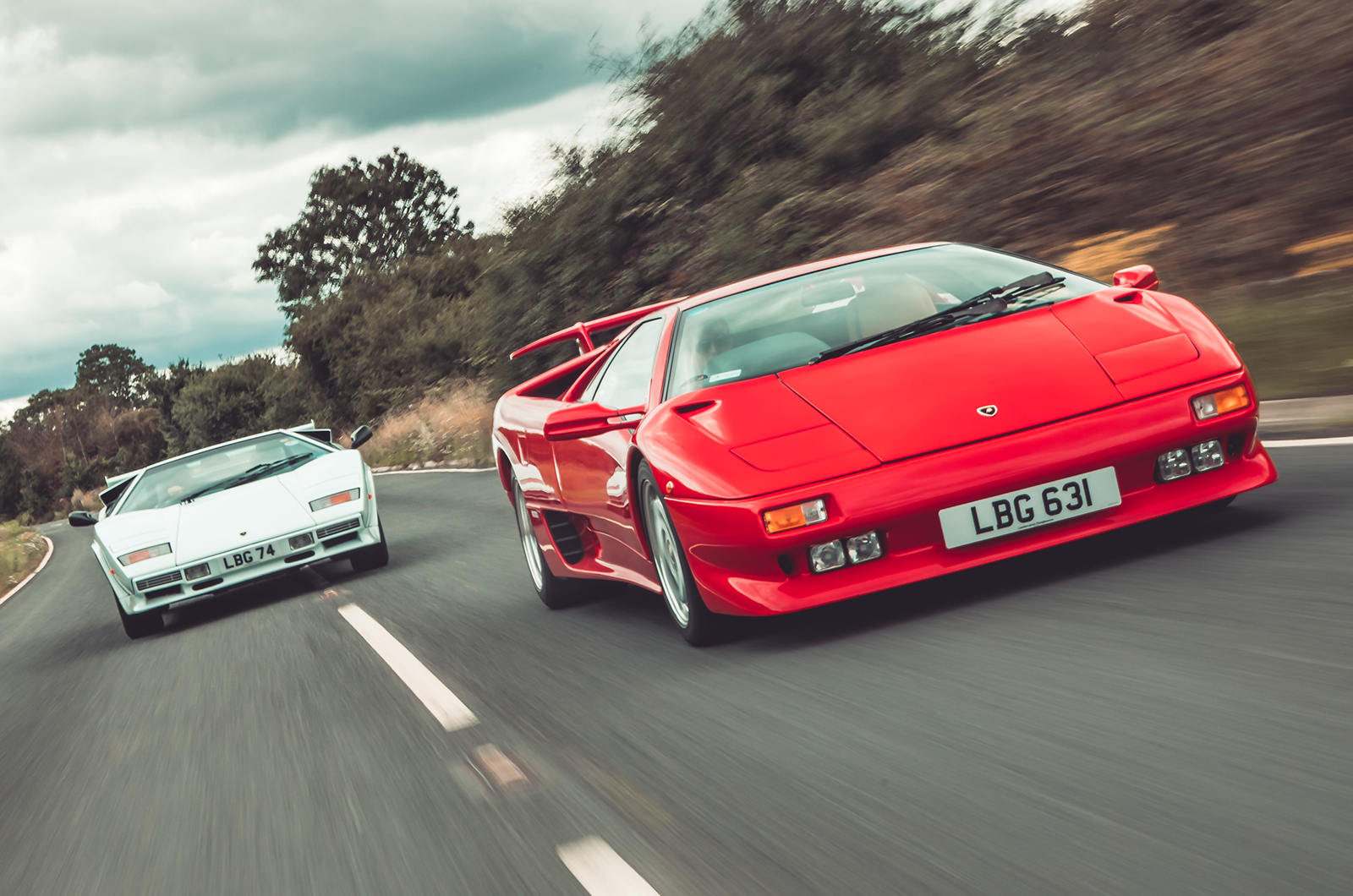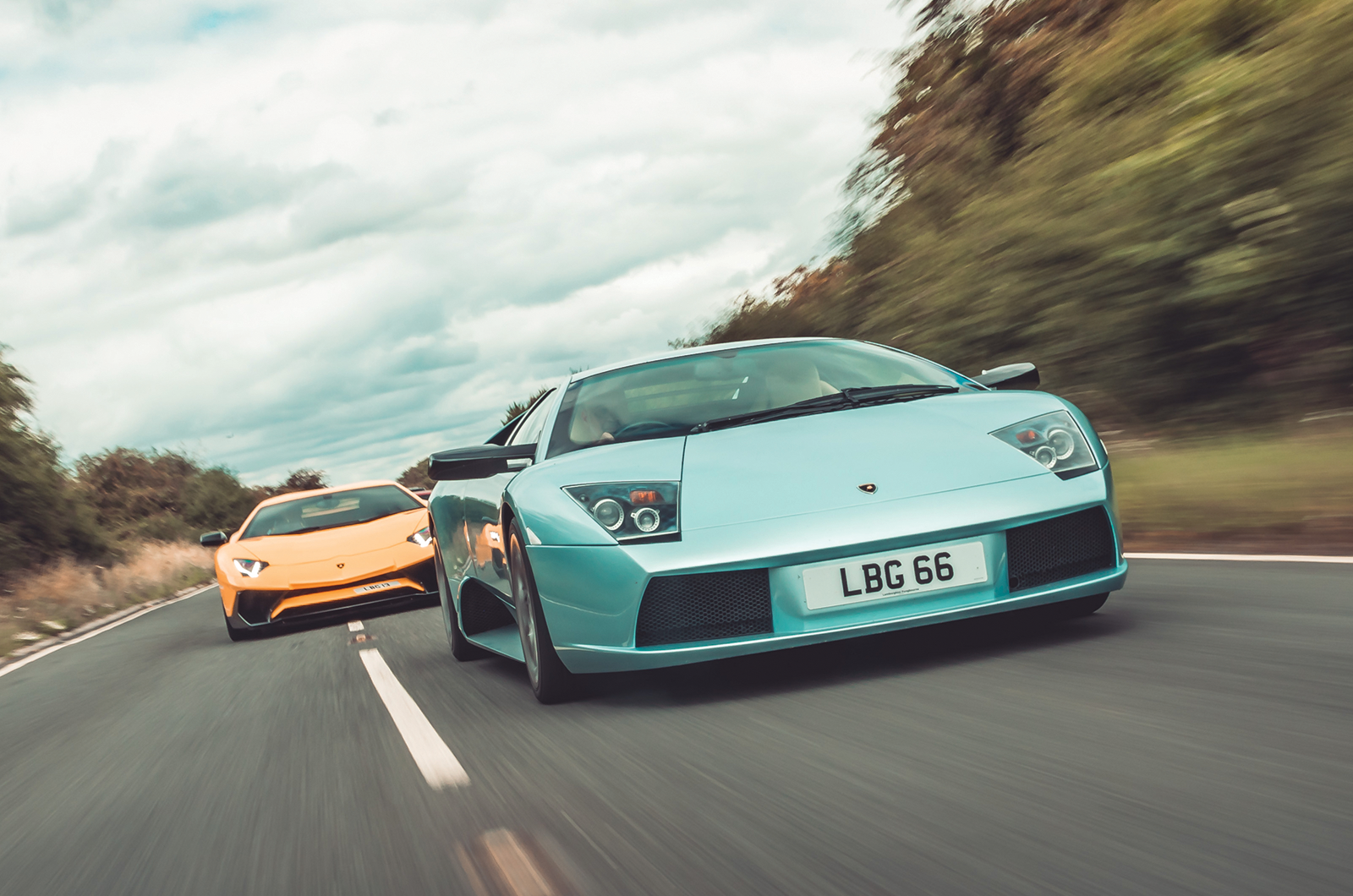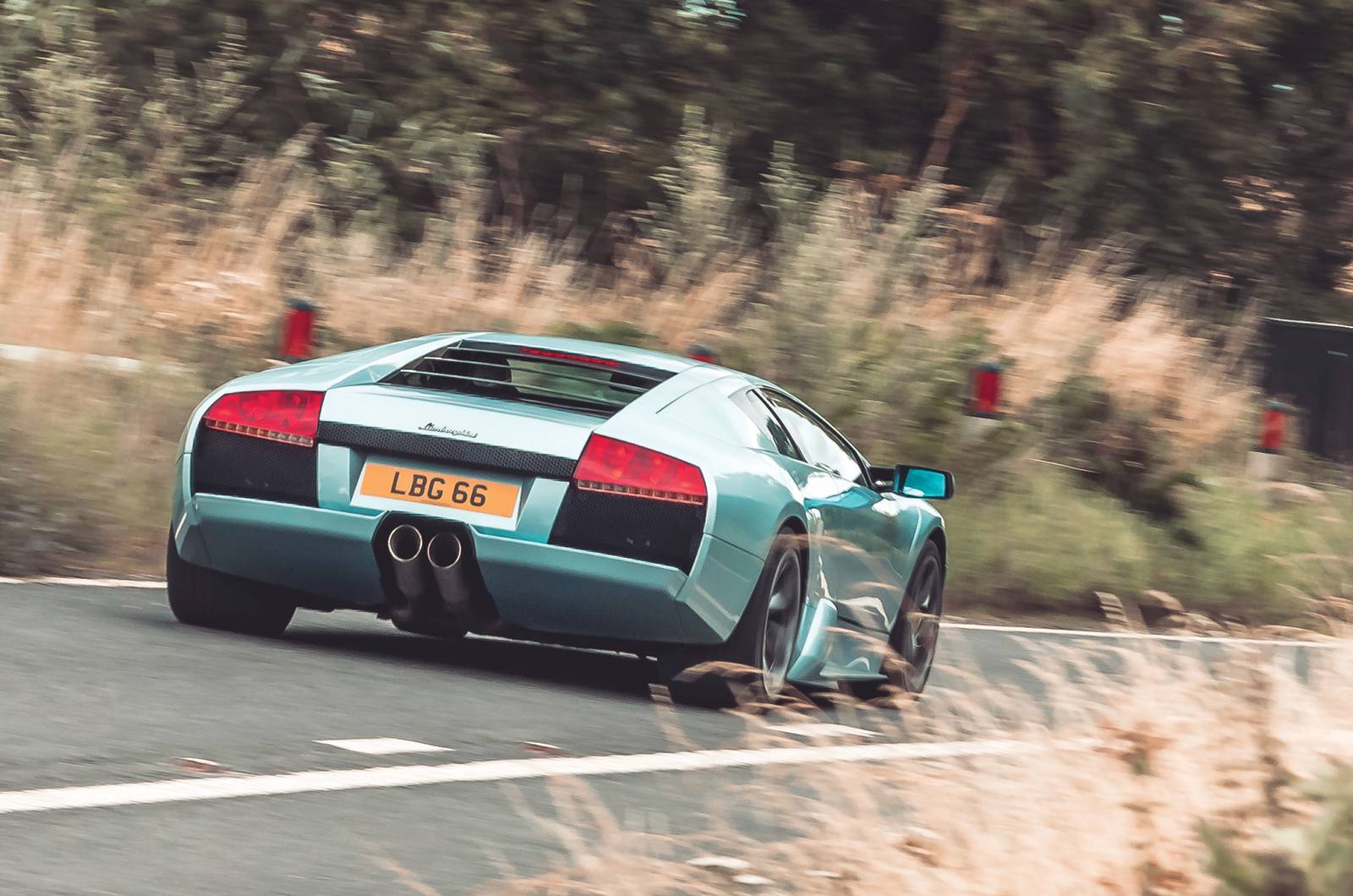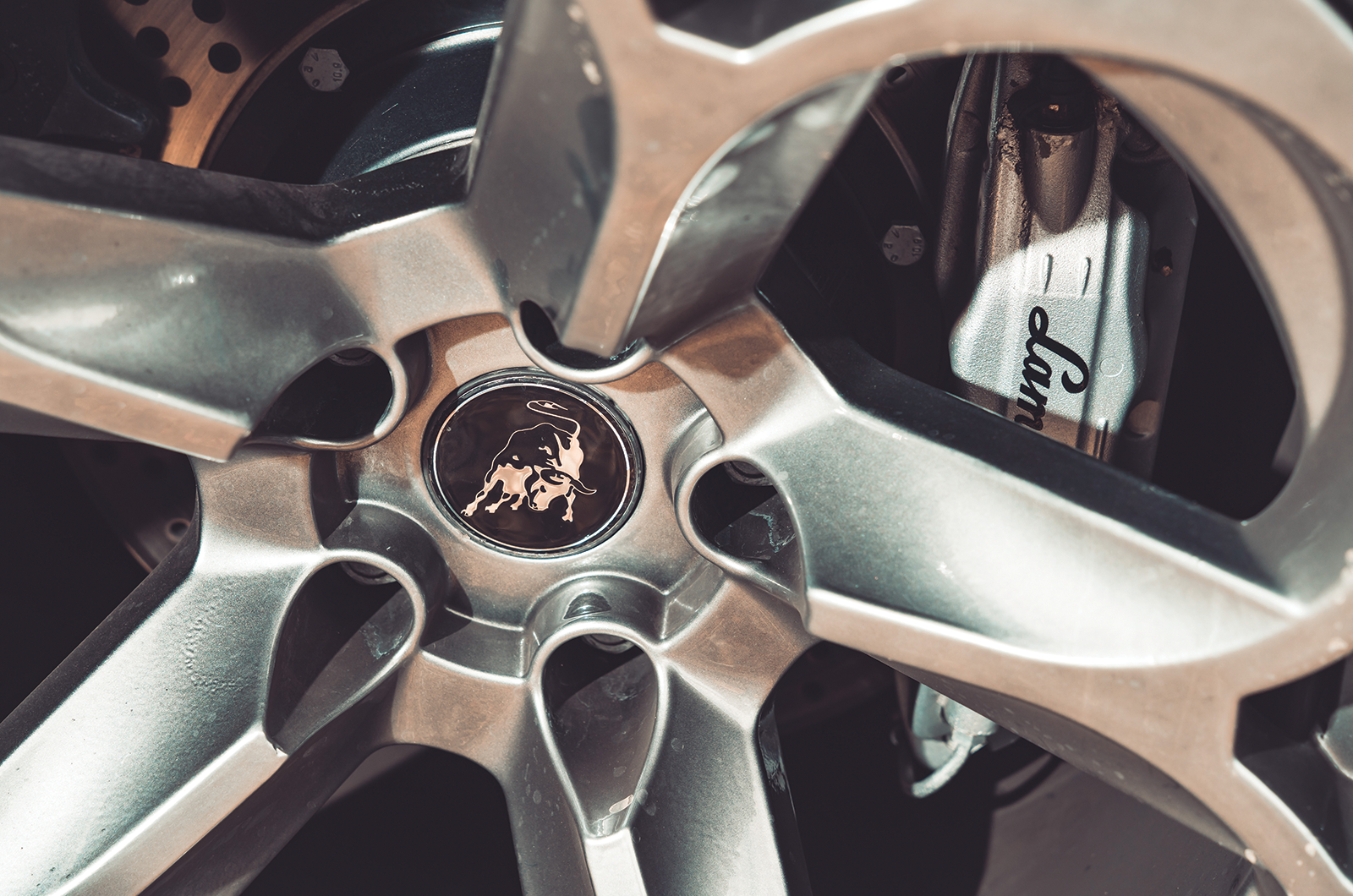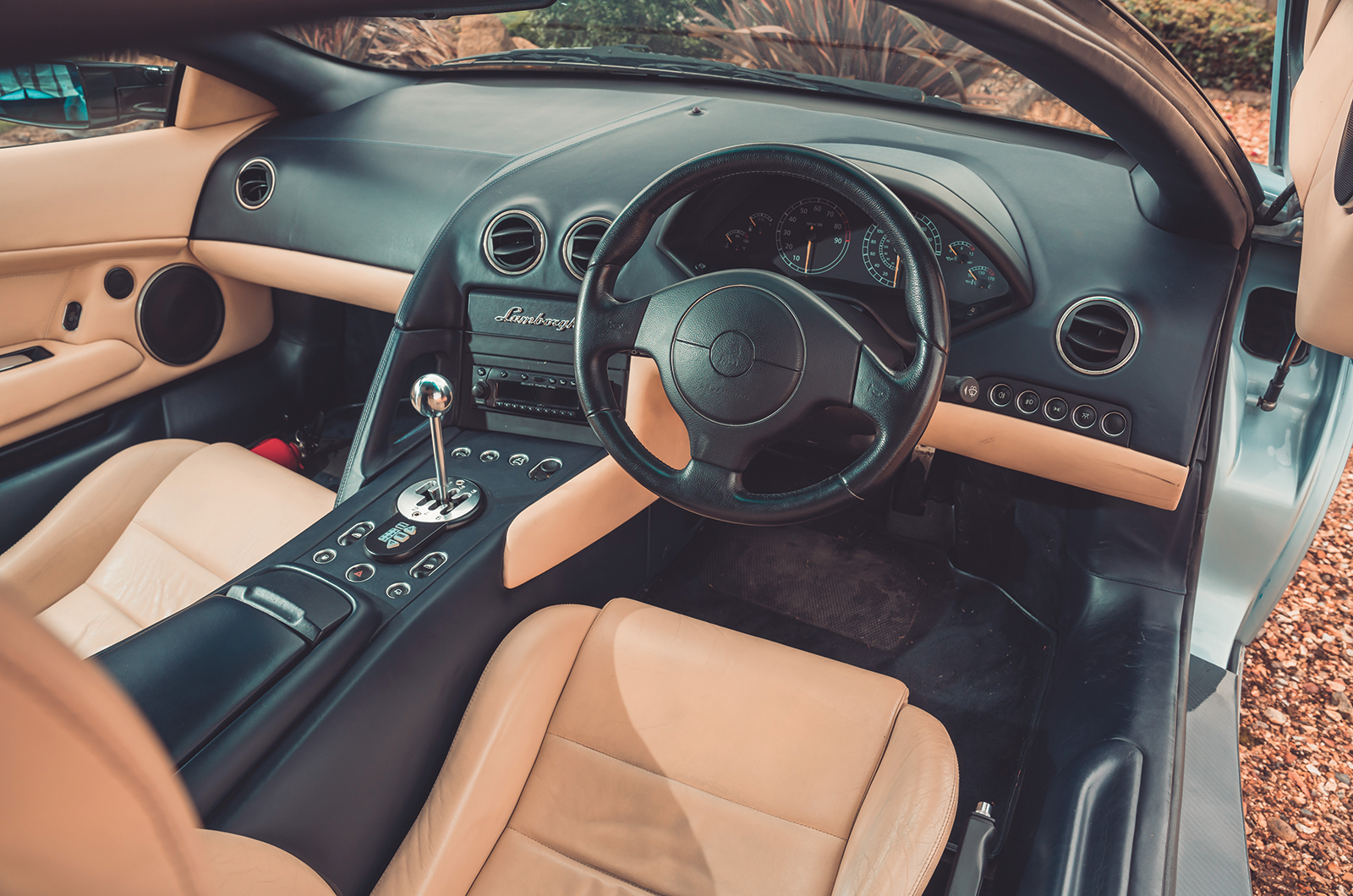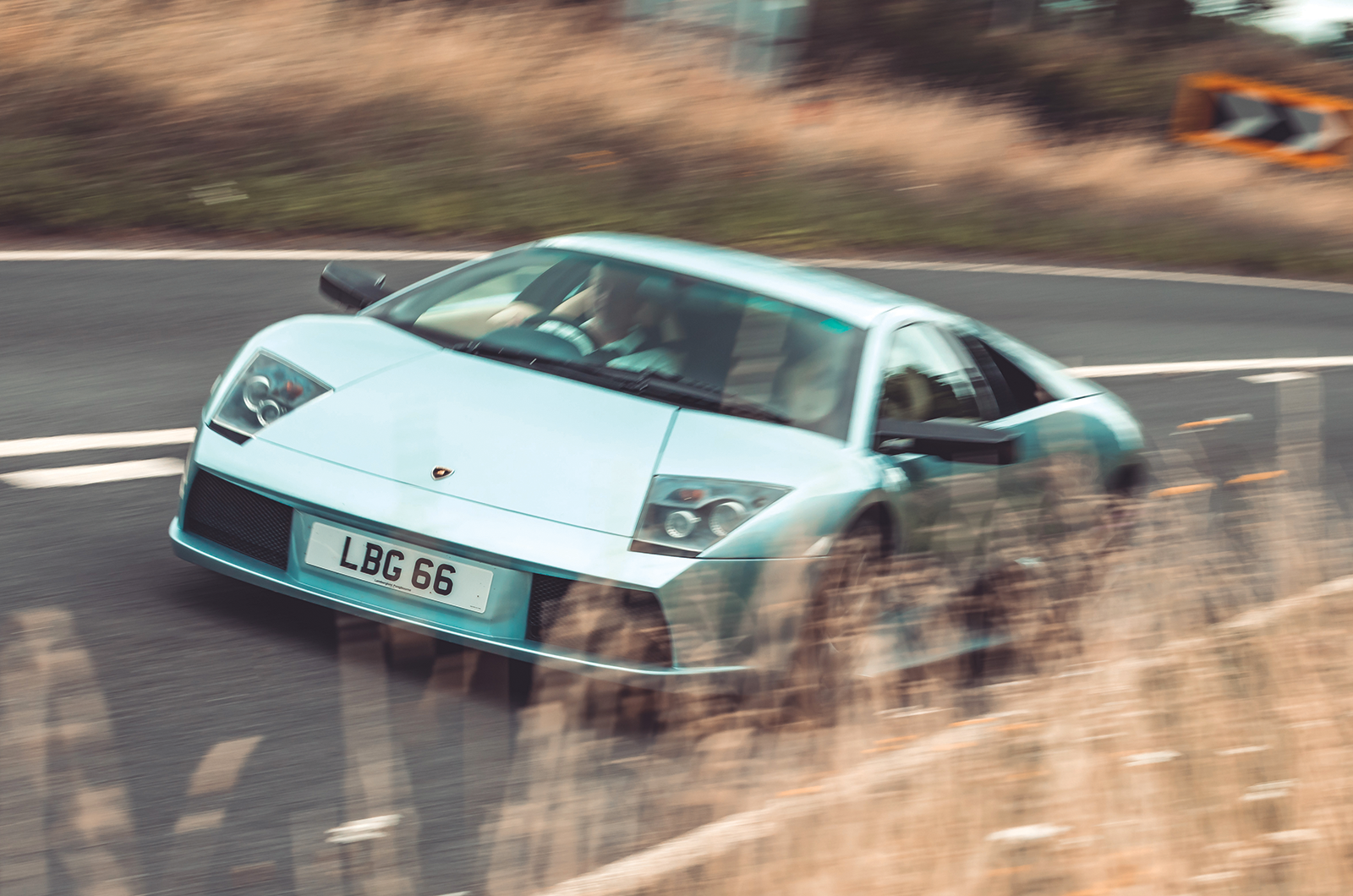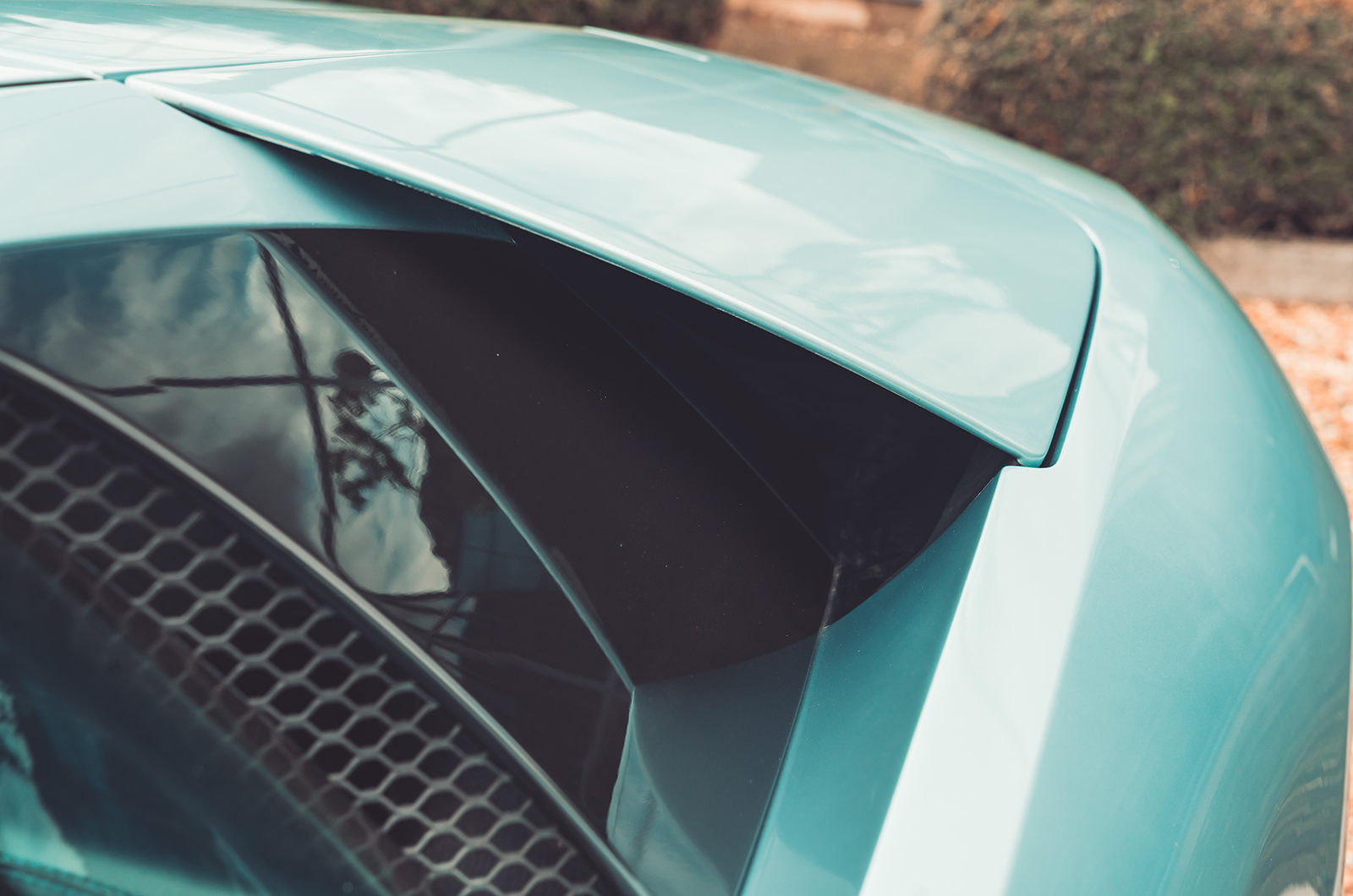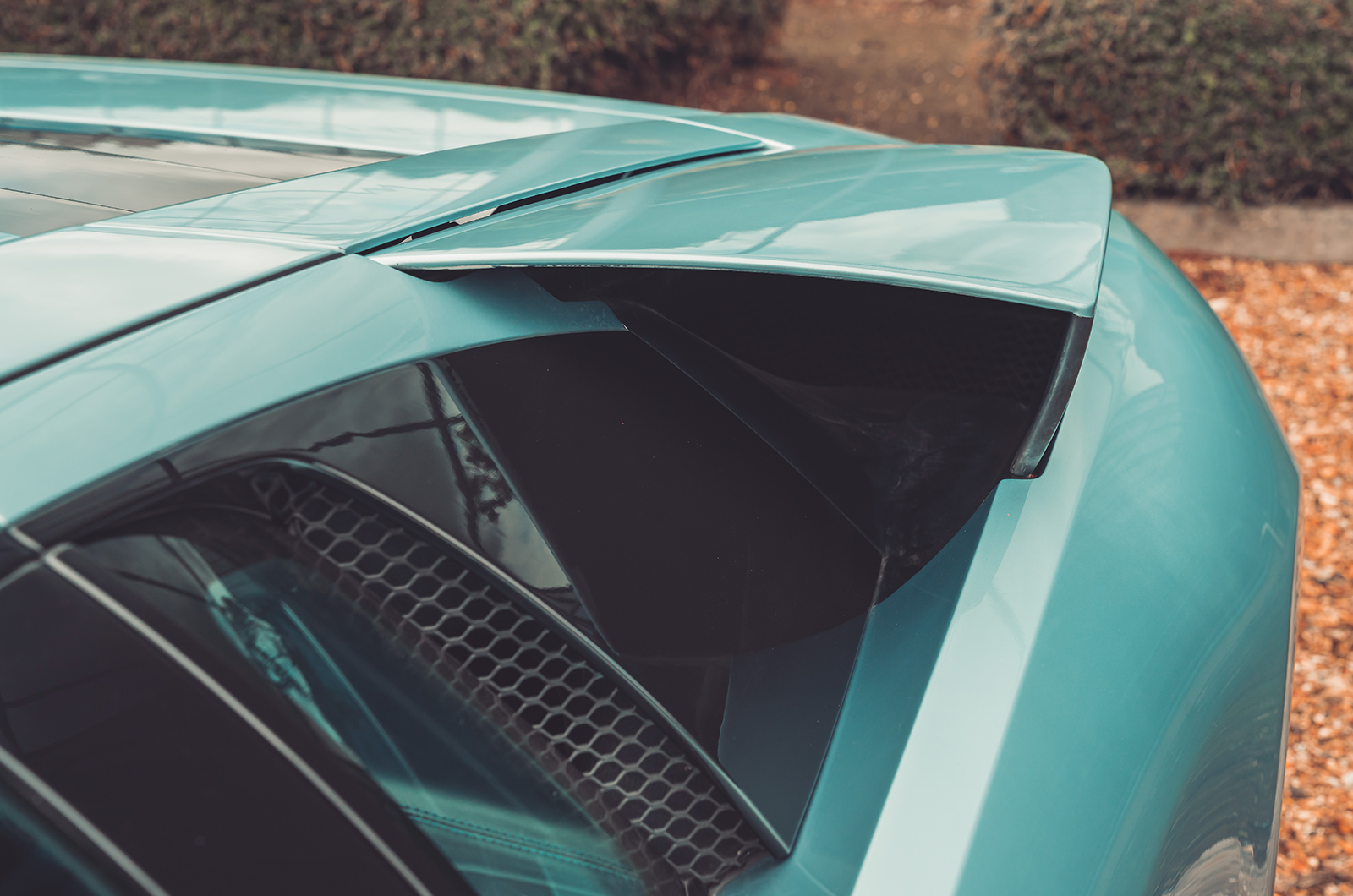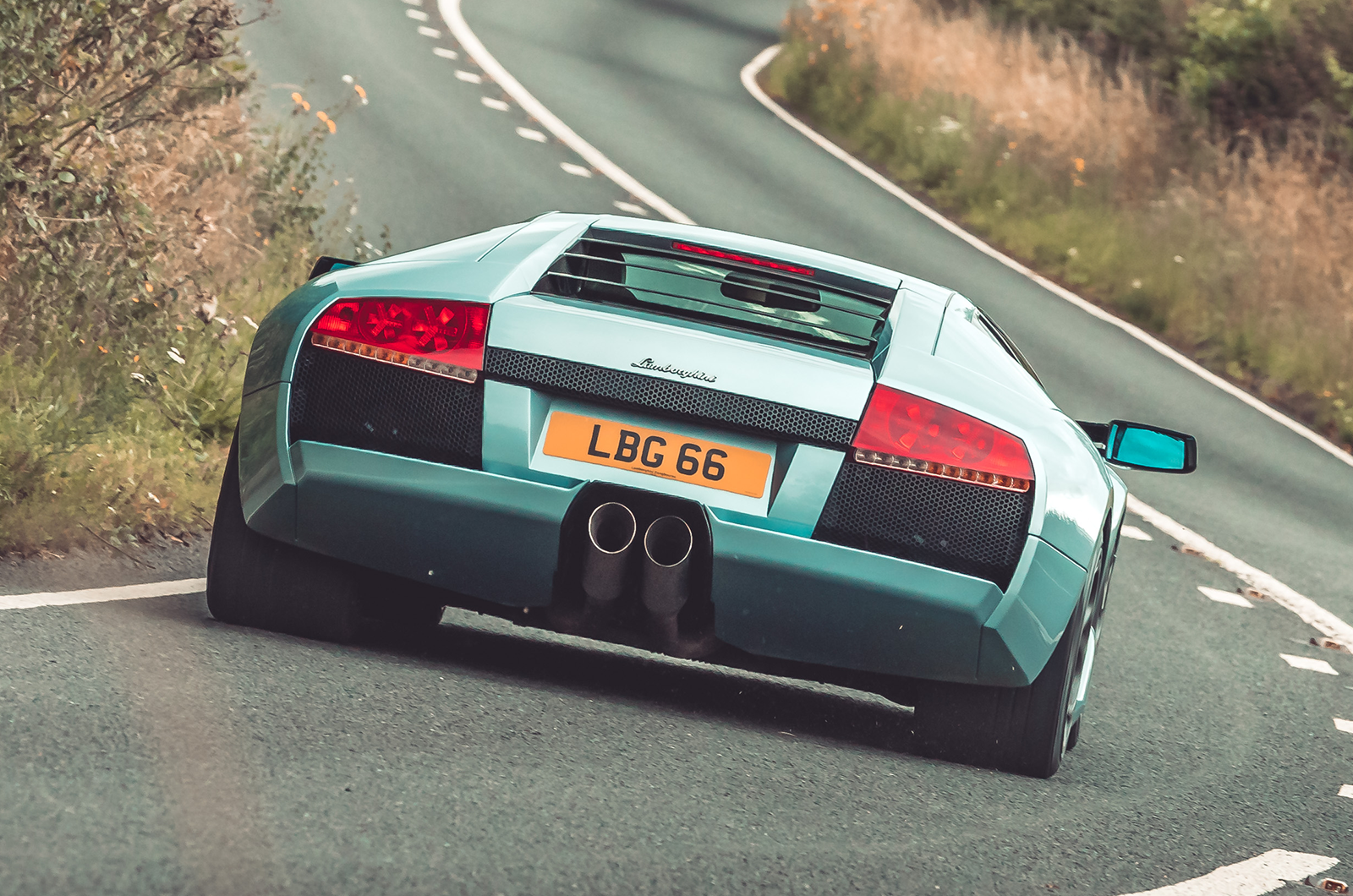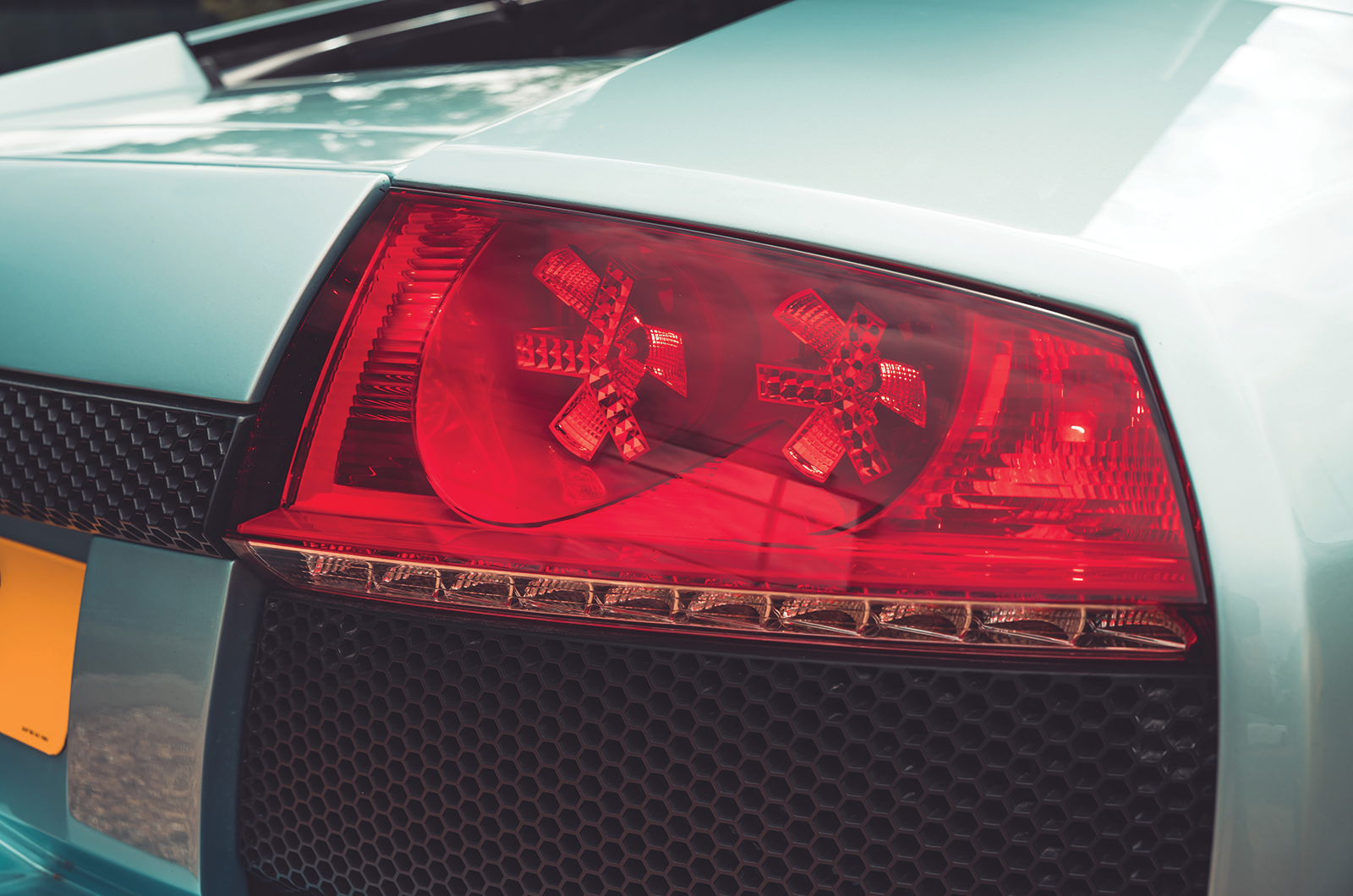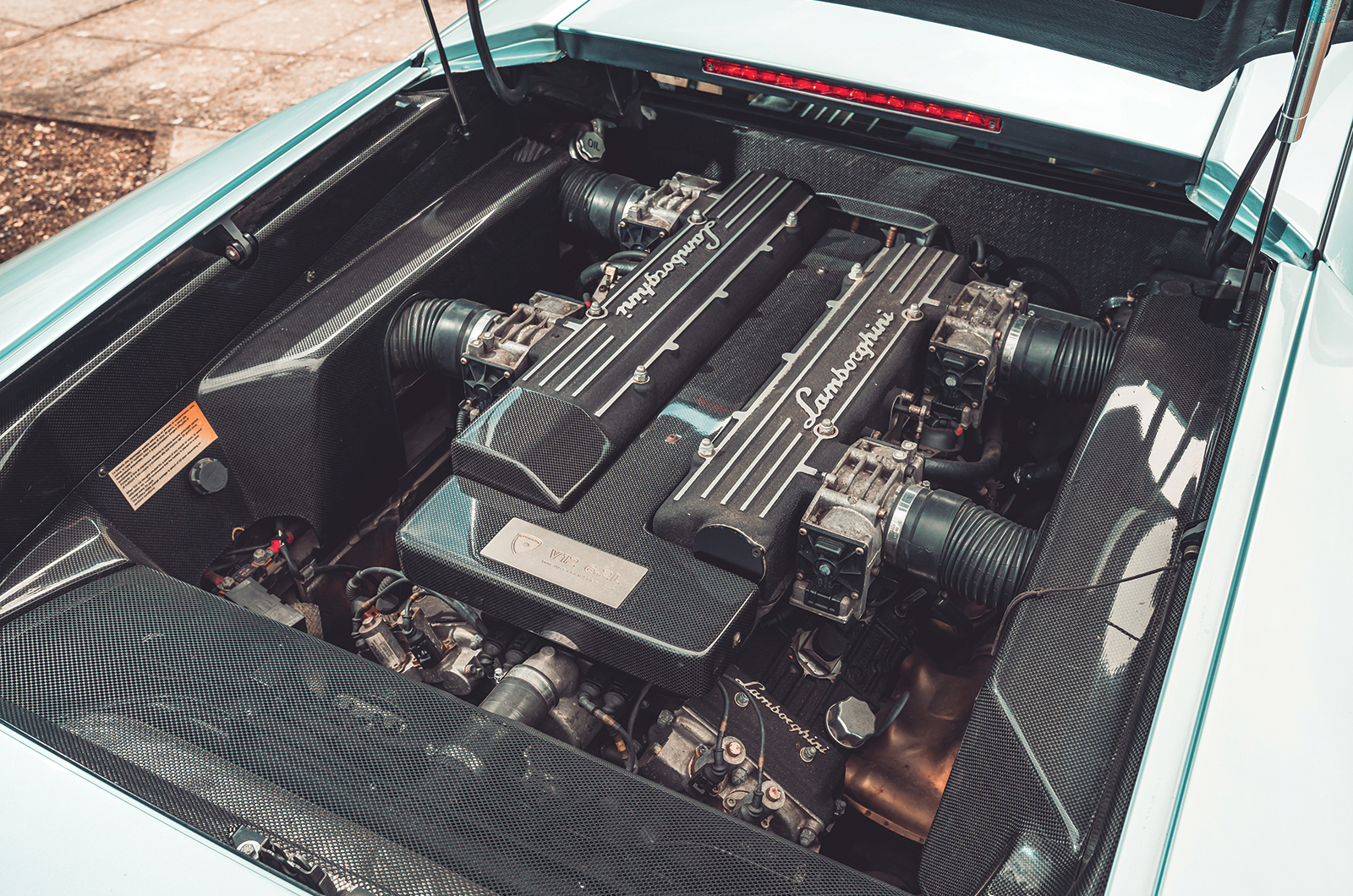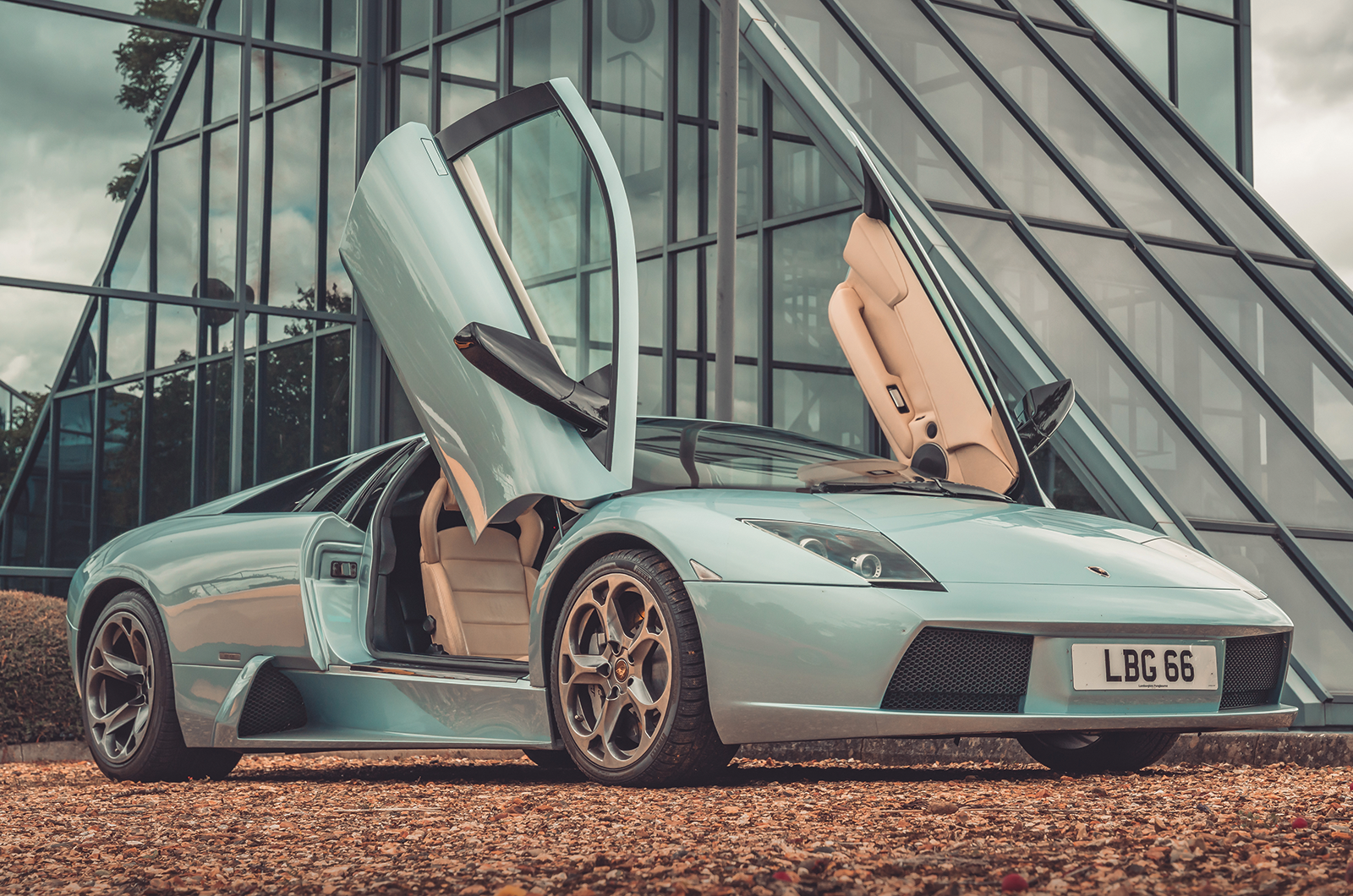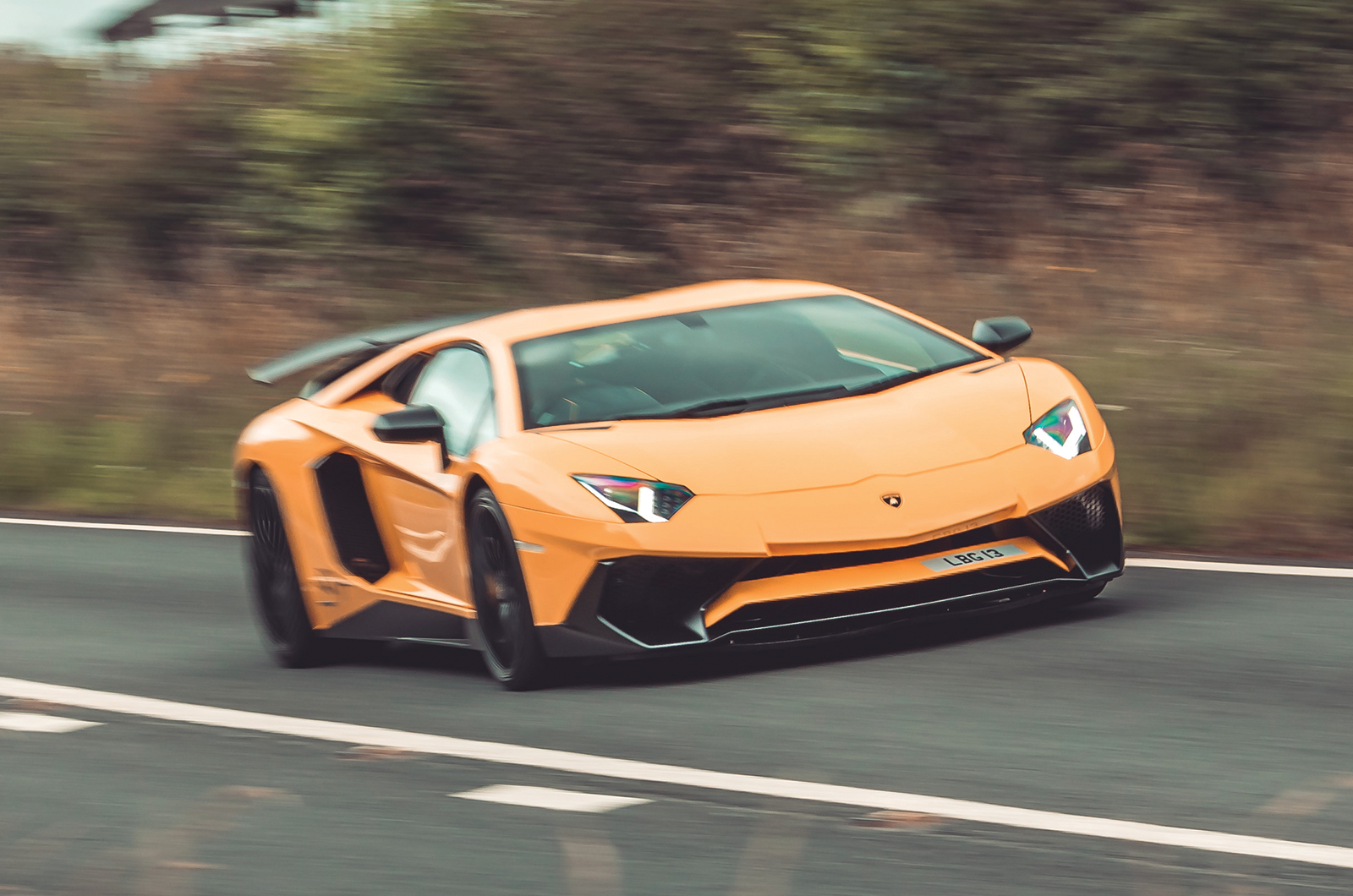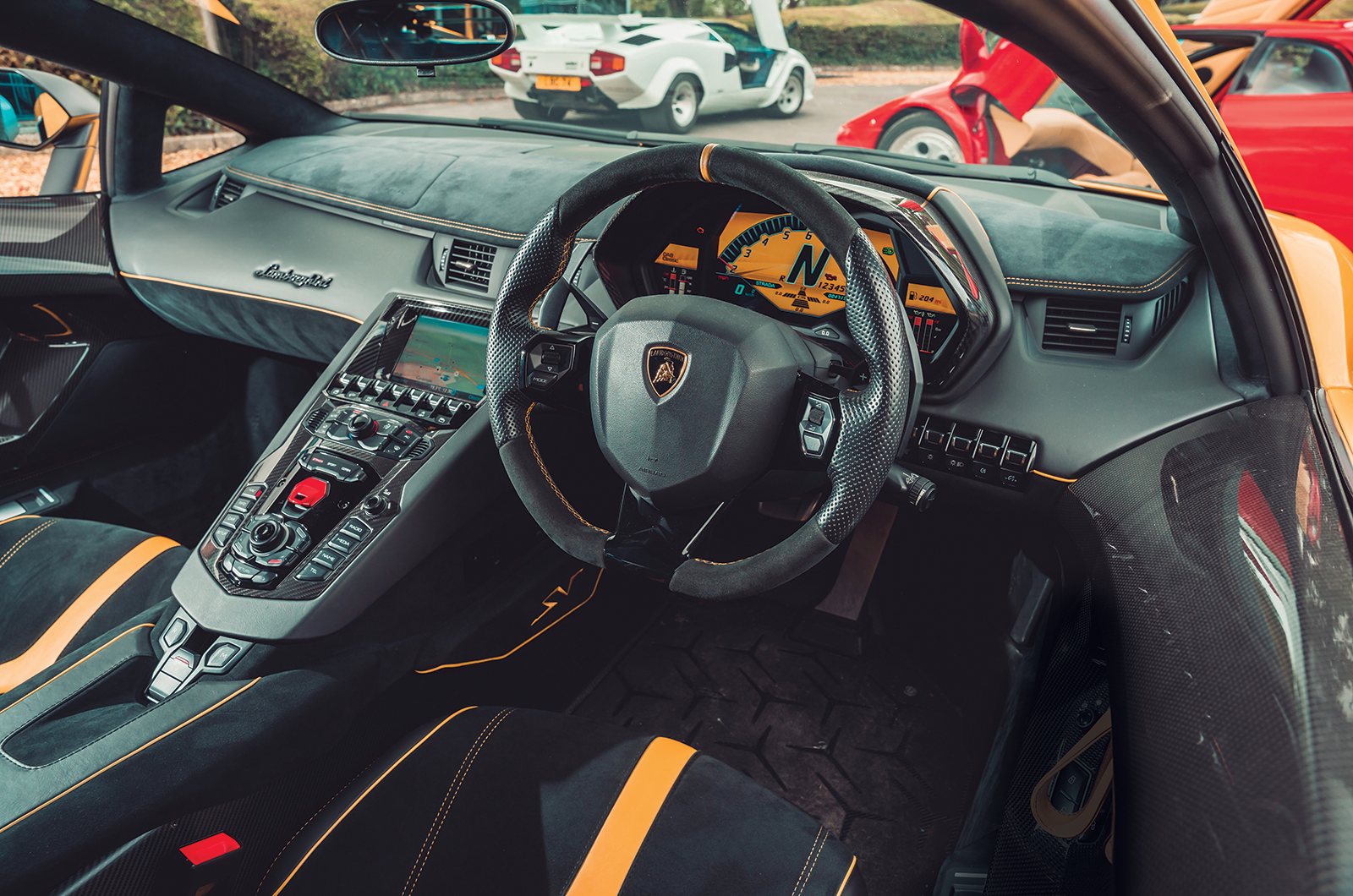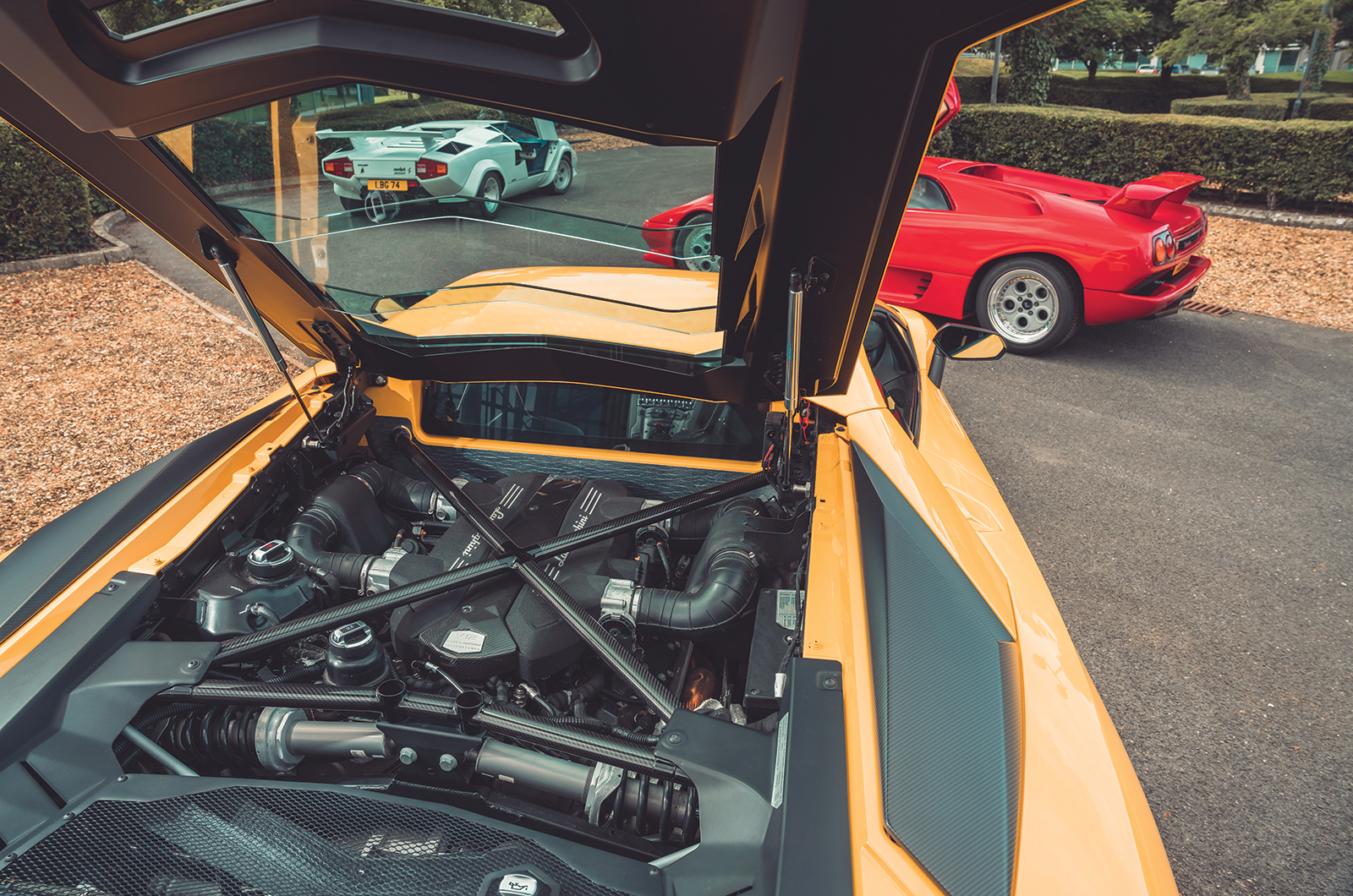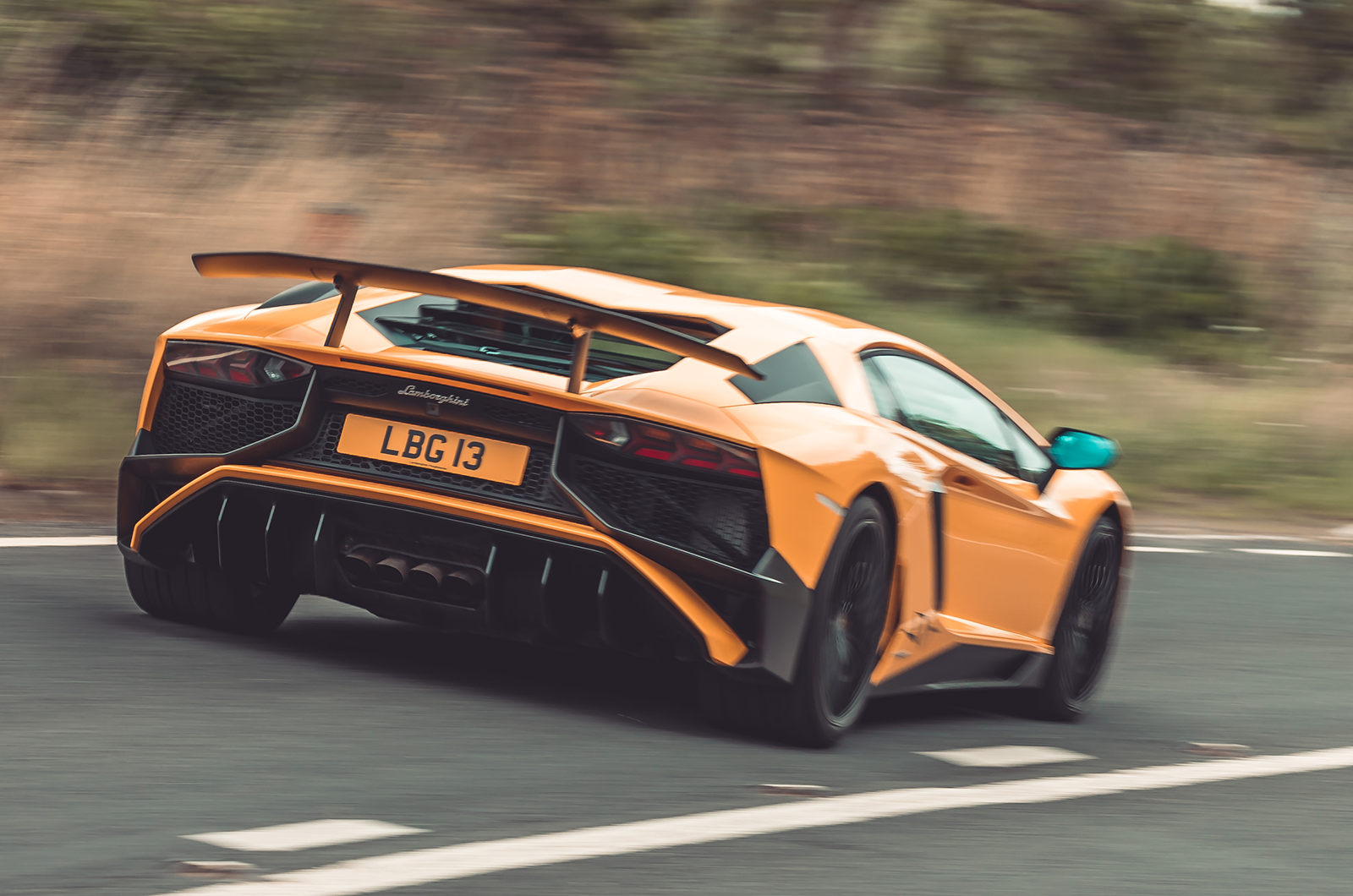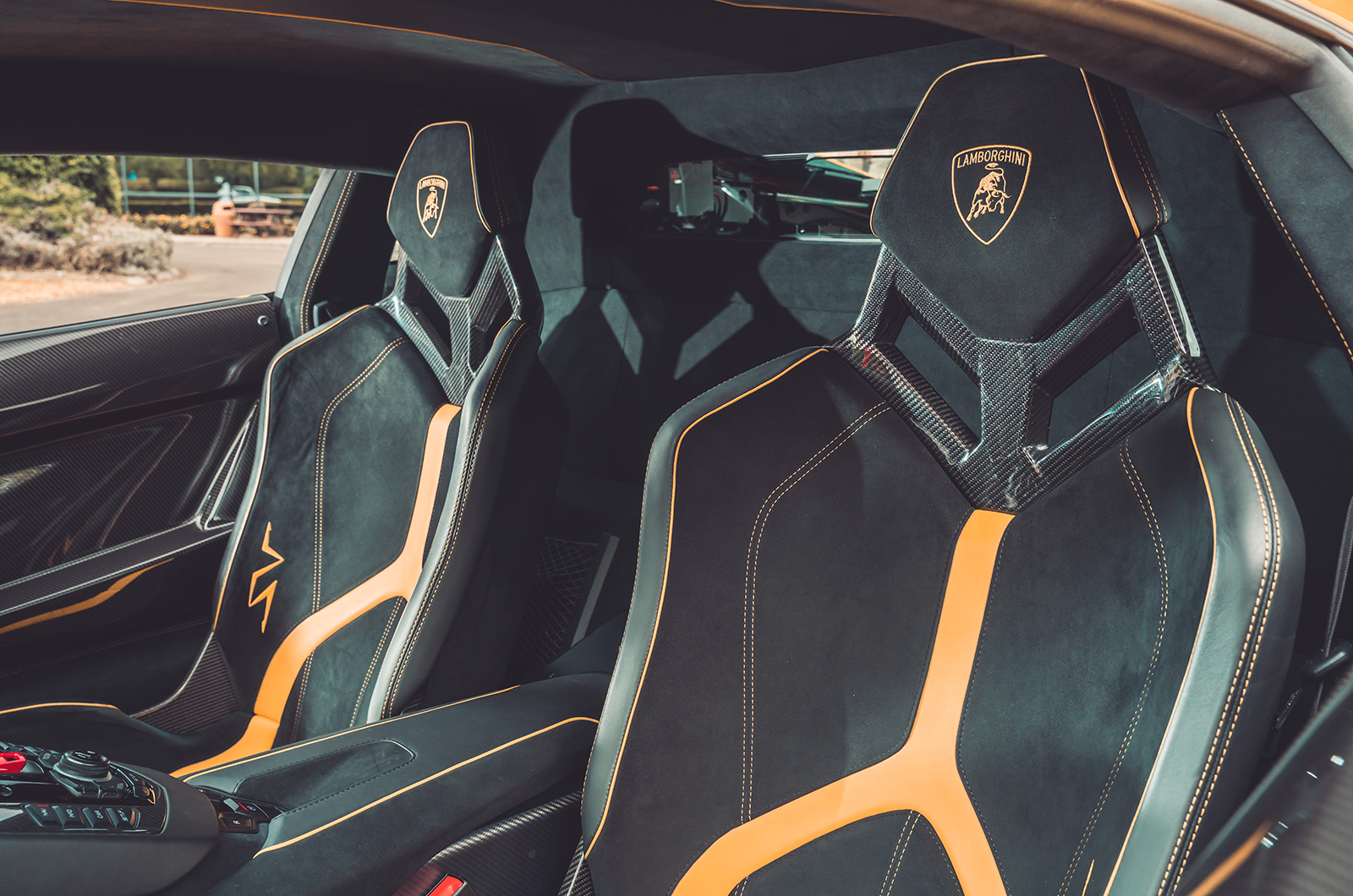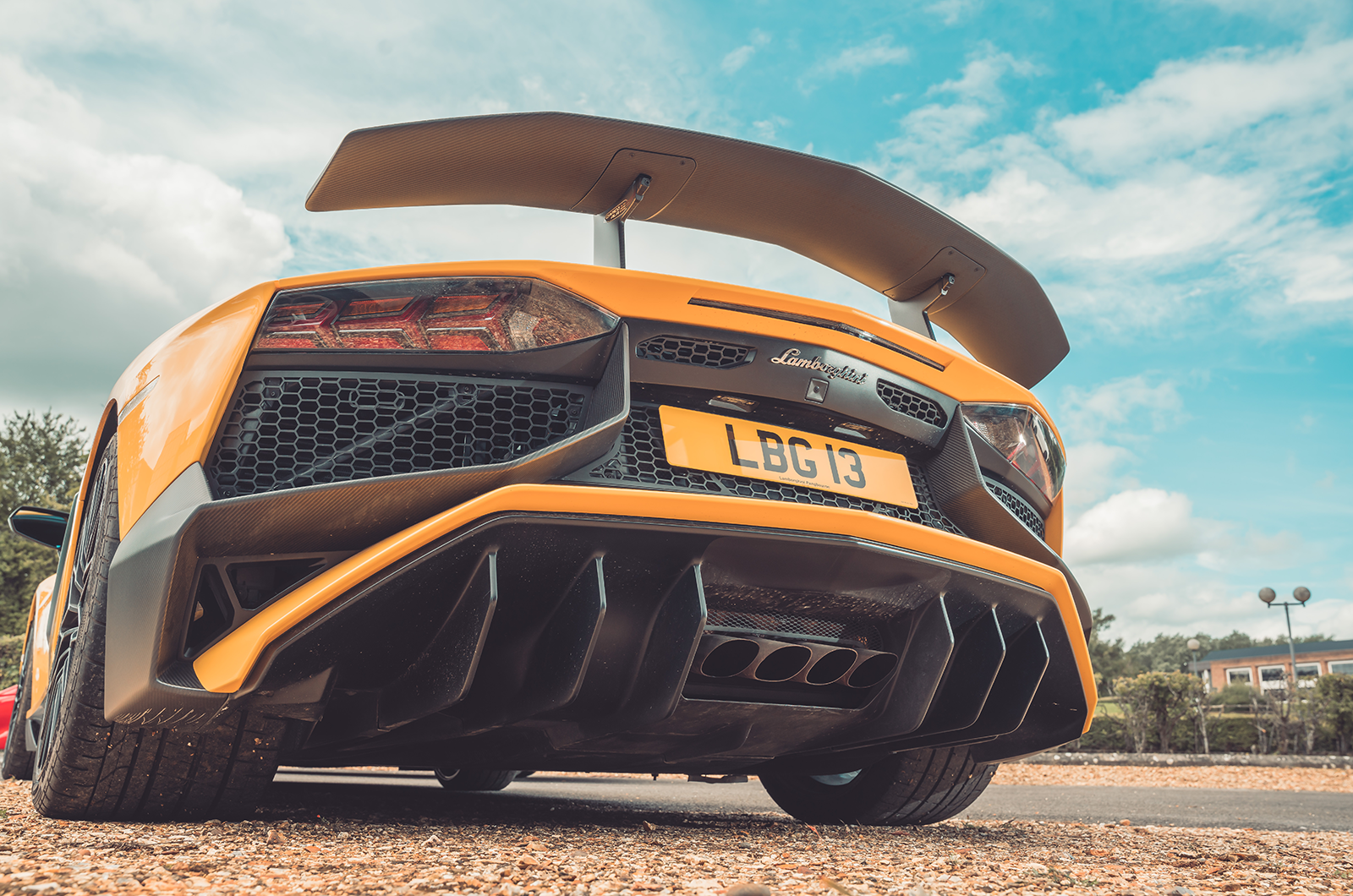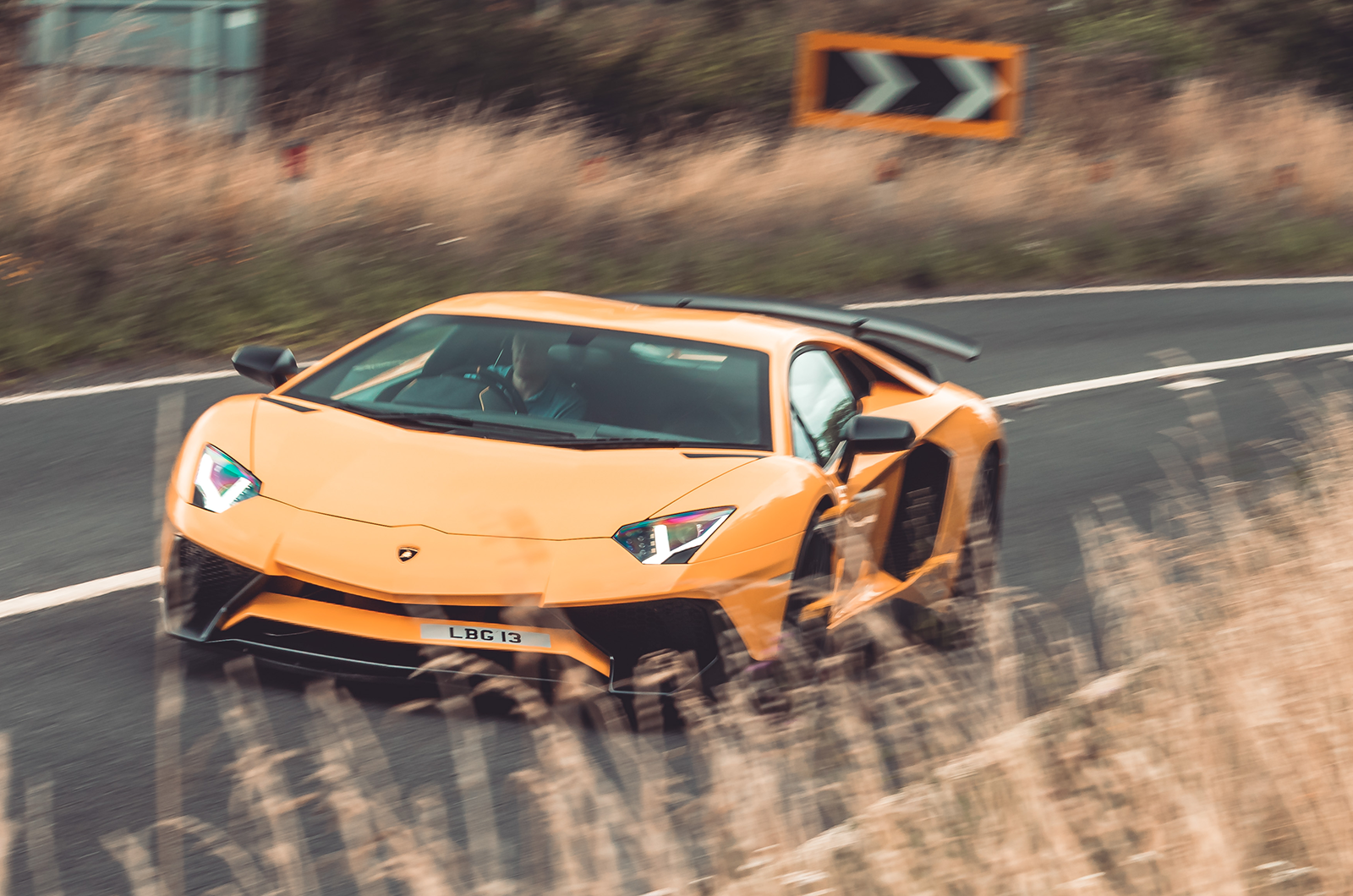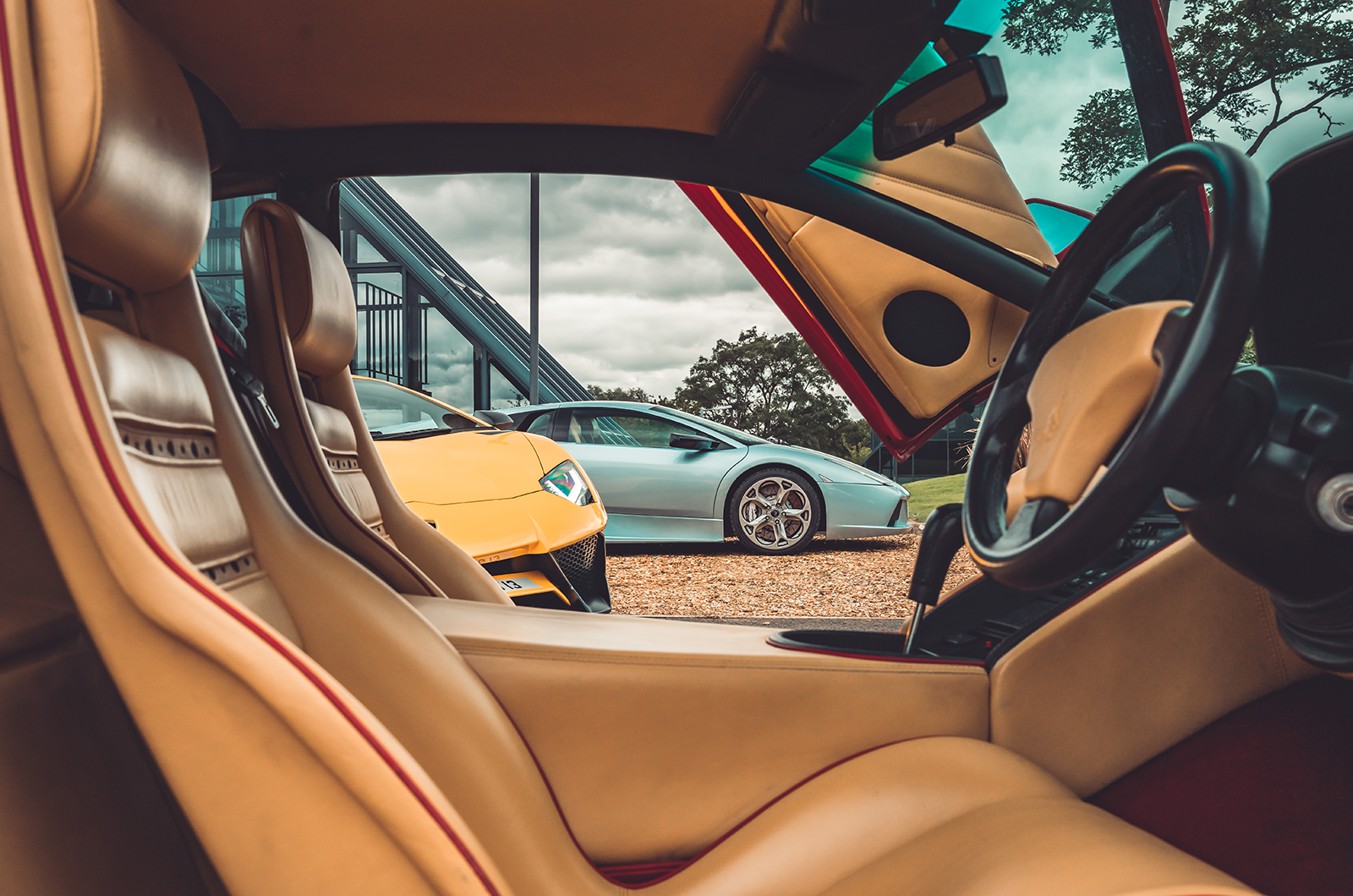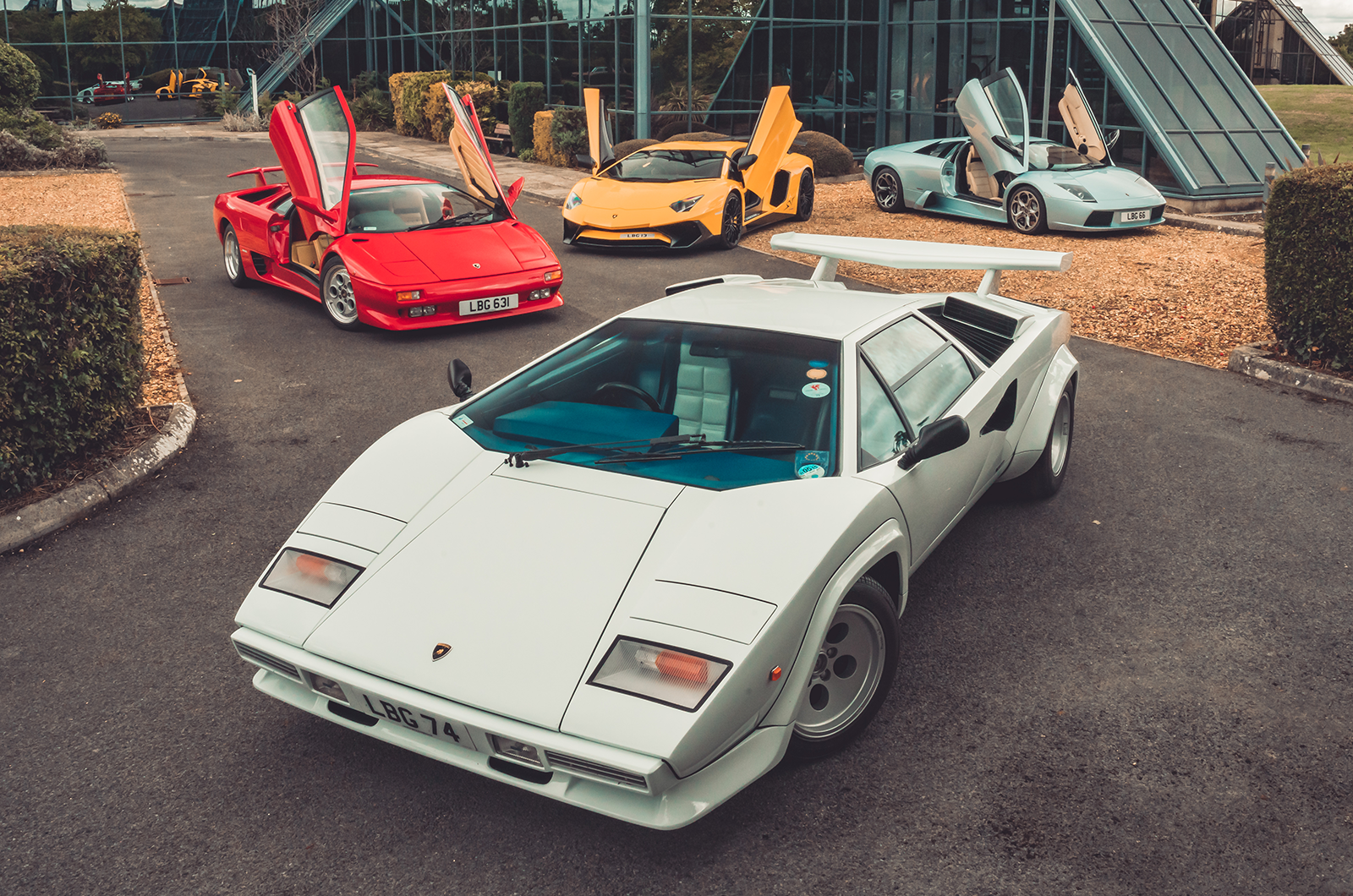If the intimidation factor of the early cars has been sealed by countless videos online of Diablos spinning out of control, it’s reaffirmed in the full-blooded intimidation of the reality, larger in every direction and 300kg heavier than the Countach.
An array of vents at the rear cut through the unique, fire-flecked red paint of ‘our’ original London motor show car, warning of the V12’s slightly unhinged fury.
The long-travel throttle begins to tear open the Diablo’s thin veneer of refinement, filling the cabin with a deep-throated, thumping roar that feels as if it could burst through the firewall behind.
The Lamborghini Murciélago’s (closest) chassis is 60% stiffer than the Diablo’s, while the Aventador was the first to switch to a monocoque
Its long gearing takes meaty strides into increasingly blurry scenery, but changes are heavy and fussy, not helped by a narrow pedalbox.
Yet you can’t help but persist, fuelled by the adrenalin from salvos of throttle with downshifts, and it begins to come together.
Heavy steering and slightly wooden brakes loosen up with speed and heat; so, too, the suspension, which becomes surprisingly pliant and the tyres happy to pour its 428lb ft of torque into the Tarmac.
‘Revs rise with a frenetic yet smooth wail that matches perfectly with the quick, uncorrupted responses at the steering wheel’
There’s even a neutral balance that shifts intimidation into the intoxication of carrying the momentum of that charging V12. Still, thin veneers are worth remembering…
Yet they were almost forgotten with the 2000 facelift.
Following the 1998 buyout, Ferdinand Piëch was fond enough of the Diablo to open Volkswagen’s coffers for new styling inside and out, variable valve timing, revised suspension and brakes, plus production improvements wrought by the installation of Audi execs at Sant’Agata.
The Lamborghini Murciélago’s traction-controlled four-wheel drive gives oodles of agility and grip
Simplified and revitalised, the final iteration was a promising sign of the future.
When the choreographed dust settled at the foot of a volcano in Sicily for the preview of Lamborghini’s new flagship in 2001, it was clear that the drama had been rescued along with the company.
The 1990s had been tumultuous.
Mostly drowning in the red, a 1994 buyout by Megatech (the Indonesian firm behind the Diablo-derived Vector M12) had floated just enough cash to begin work on a new junior Lamborghini, but mostly left designers’ hands tied into rounding off corners around old fixed points for the Diablo successor.
The manual gearshift changed from dog-leg to H-gate for the Lamborghini Murciélago
When VW took over in ’98, the existing ‘P147’ proposals were sent off for a hasty redesign to Gandini, IDEA, Stile Bertone, Hueliez and an internal designer called Luc Donckerwolke, who had graduated from Audis and Škodas to leading the Diablo refresh.
Against a deadline of barely 12 months, it was 34-year-old Luc’s simple sketch that got the green light in May ’99: a single arc from front to rear, in Countach and Diablo fashion, cut off sharply front and rear by huge air intakes.
It was a step-change that left previous designs, and rivals, looking soft, fussy and dated.
The Lamborghini Murciélago was a commercial success for the marque
The technical pièce de resistance was motorised rear intake scoops, which folded flat into the car’s neat lines when stationary, but opened when temperatures rose or at speeds above 130kph (80.8mph).
The name Murciélago pandered to enthusiasts invested in Lamborghini’s history: in honour of an animal that, in Córdoba in 1879, continued fighting after sustaining 24 sword strokes by legendary matador Rafael Molina Sánchez.
Ambitions for a comfortable cabin that had been approached in the Diablo era took as large a stride forward as the exterior.
The Lamborghini Murciélago’s adaptive intakes open by up to 70° at speed
Easier to access and more spacious, its fit and finish neared Ferrari standards – and with the addition of some Audi switchgear, it was even better.
Underneath remained the fundamentals inherited via the Diablo from the Countach: a steel spaceframe, wishbone suspension and the Bizzarrini V12 placed longitudinally at its heart.
Except, like many things at Sant’Agata, the German money and principles of technical enhancement were tangible.
Carbonfibre was now used in honeycomb elements to reinforce the chassis, as well as for the floorpan and all panels bar the steel roof and doors.
‘The drive-by-wire throttle lights up the V12 with a flare of revs that the old car’s injection simply couldn’t imagine’
A full suite of computer-controlled ABS and traction control backed up a V12 stroked to 6192cc, with variable intake and exhaust valve timing, and a new dry sump – reducing the centre of gravity by 50mm.
The figures were huge: 571bhp, 206mph, and a 60% stiffer chassis while weighing just 25kg more than a Diablo VT.
Yet it feels so much lighter on the road.
Aside from the power assistance, the drive-by-wire throttle lights up the V12 with a flare of revs that the old car’s injection simply couldn’t imagine, while the gated shift of its six-speed ’box is almost playfully stirrable.
This Lamborghini Murciélago has the glitzy tail-lights from the facelifted LP640-4
On closer-stacked gears, a flatter torque curve and the confidence of traction-controlled four-wheel drive, the Murciélago can be unleashed with a pace the Diablo would have to work up to.
Revs rise with a frenetic yet smooth wail that is slightly subdued in the cabin, but matches perfectly with the quick, uncorrupted responses at the wheel.
The structure feels strong and the chassis controlled, even meeting mid-corner bumps, with the stability-control telltale only flickering when you plant the throttle too abruptly.
The Lamborghini Murciélago was the last gasp for the classic Bizzarrini V12 engine
Despite having less sweaty-palmed feedback than its predecessors, the Murciélago responds to the same considered approach, rewarding with a remarkable balance of drivetrain clarity, agility and grip that makes
it feel the most like a sports car of the group.
Development of the engine that Lamborghini engineers had once thought was approaching its limits continued for increasingly extreme versions of the Murciélago.
In 2006 the revised LP640-4 arrived, also in the Roadster form introduced two years earlier, bringing the advertised 640PS (631bhp) along with a general facelift, from which ‘our’ early car borrows its glitzy tail-lights.
Luc Donckerwolke’s design for the Lamborghini Murciélago was an instant classic
In 2009, the SV name returned for the LP670-4, a hyper-aggressive flagship that, with bigger air intakes, extra carbonfibre trim and the popular option of a rear wing, marked the model’s ultimate ambition to be the Stealth bomber of collectors’ garages.
The Murciélago was a stunning success for Lamborghini.
Its starting price of £163,000 in 2002 wasn’t much more than a Ferrari 575M Maranello, and 424 were sold in its first full year of production.
The wild Lamborghini Aventador arrived in 2011
Demand didn’t let up: assisted by the junior Gallardo, Sant’Agata was now rolling out thousands of cars each year.
On a high of 2000s-era easy credit and emerging market wealth, Volkswagen had the money to develop an all-new successor for introduction just 10 years after the Murciélago’s launch.
Not only that, it also had a clear direction: essentially, to build the wildest, sharpest, most poster-worthy Lamborghini yet.
You can’t criticise the Lamborghini Aventador’s moody cabin for lacking drama
Donckerwolke’s successor, Filippo Perini, had sharpened his pencil on the limited-run 2007 Reventón and 2010 Sesto Elemento, both of which explored fighter-plane design themes to the extreme, and his proposal for 2011’s V12 flagship Aventador was chosen out of a set from Italdesign and various internal studios.
Serrated into violent hexagons, the body of the Aventador cuts in and out around the traditional Lamborghini razor-edged profile with outrageous aggression.
The brief for project LB834 had been to design a completely new car, partly because the mechanicals would be different, too.
The all-new engine for the Lamborghini Aventador was developed with Audi
A new carbon monocoque replaced the old spaceframe, while aluminium subframes carried forged alloy wishbones and pushrod coilovers, and a new V12 was completely re-engineered in the shadow of the old Bizzarrini unit.
Still banked at 60°, it was a more oversquare design despite the same 6498cc, with a 95mm bore and 76.4mm stroke against the previous 88 x 89mm, so that, with other fresh internals, it could muster 690bhp on its way to the heady 8500rpm limiter.
An automated-manual gearbox had been planned for the 1990 Diablo, but only arrived in 2004 for the Murciélago.
‘Our’ Lamborghini Aventador LP750-4 SV is a roadgoing missile
For the Aventador it was the sole option and, as the rest of the market opted for double-clutch automatics, Lamborghini’s decision to go all-in on its pre-selecting single-clutch transmission would become a rare point of criticism.
Priced at £242,000, with options taking it much further, Lamborghini clearly had eyes on the money it should have been making in its less stable past.
Sales took off. Despite having keenly prepared for mass production, premiums and waiting lists grew to such an extent that Sant’Agata was able to package two Gallardos with each Aventador that dealers were desperate to have delivered.
The Lamborghini Aventador’s bucket seats aren’t built for comfort
From 2013, more than 1000 V12 monsters were being sold each year. The showroom appeal was powerful.
Beyond Perini’s wow shape, and doors that took on an outward angle as they rose up, was an interior made in jet-fighter dreams.
The extravagant gloss of performance is even greater in the Alcantara- and carbonfibre-trimmed SV that bookends our set.
The Aventador SV’s sizable rear wing is much more effective than the earlier attempts
The standard bucket seats are as unforgiving as the aerodynamic addenda outside are to anyone unlucky enough to get in the way of this roadgoing missile.
Lifting the red cover to the centre-console-mounted starter button might seem a bit silly for those not rightly intimidated by the tones of 740bhp building behind you.
The electrically assisted steering is quick and easy, but you can feel the huge front tyres twisting awkwardly over slow Tarmac and the ’box slurs clumsily on small throttle openings.
The SV sheds 50kg compared to the standard Lamborghini Aventador
Confirming that this is a considerably more serious car than a standard Aventador, or the lighter Murciélago, is the hollow road noise and crackle of stone-chips that resound through the carbon tub.
Lean on the accelerator and it fires forward with startling immediacy, revs screaming with equal ferocity and the dash lighting up with warnings to slot in the next gear.
Pull the paddle and it pummels your backside with the change then resumes acceleration that would leave the others standing.
The dramatic scissor doors are a key feature of these V12-powered Lamborghini flagships
Brakes, steering and the SV’s magnetic dampers are all intensely occupied with translating your next thought into action, abandoning some of the delicacy of its earlier brethren.
Yet there is a familiar sweetness to the way it hooks up under power, particularly out of its preferred long-radius corners.
As if the SV wasn’t enough of a monster, a 769bhp SVJ LP770-4 followed a facelifted Aventador in 2018, with even more aggressive aerodynamics, before the final LP780-4 Ultimae in 2021.
While Ferruccio’s original philosophy has resulted in more accessible, usable cars, their buyers’ fascination with performance thrills has pushed the company into producing utterly absorbing, ready-made danger.
With scissor doors and a huge wing, it is the distillation of drama.
Images: Max Edleston
Factfiles
Lamborghini Countach 5000S
- Sold/number built 1974-’90/1983 (all)
- Construction steel spaceframe chassis, aluminium body panels
- Engine all-alloy, dohc-per-bank, 24v 4754cc 60° V12, six Weber carburettors
- Max power 375bhp @ 7000rpm
- Max torque 302lb ft @ 4500rpm
- Transmission five-speed manual, RWD
- Suspension independent, at front by double wishbones rear lower wishbones, upper links, radius arms; coil springs, Koni adjustable dampers, anti-roll bar f/r
- Steering rack and pinion
- Brakes discs, with servo
- Length 13ft 7in (4140mm)
- Width 6ft 6¾in (2000mm)
- Height 3ft 6⅛in (1070mm)
- Wheelbase 8ft ½in (2450mm)
- Weight 2913lb (1321kg)
- 0-60mph 5.6 secs
- Top speed 164mph
- Mpg 14.6
- Price new £54,000 (1983)
- Price now £3-600,000*
Lamborghini Diablo
- Sold/number built 1990-’01/2884 (all)
- Construction steel spaceframe chassis with carbonfibre reinforcement, steel and carbon/glassfibre panels
- Engine all-alloy, dohc-per-bank, 48v 5707cc 60° V12, Weber-Marelli sequential multi-point fuel injection
- Max power 492bhp @ 7000rpm
- Max torque 428lb ft @ 5200rpm
- Transmission five-speed manual, RWD
- Suspension independent, by double wishbones, coil springs, telescopic dampers (twin at rear), anti-roll bar f/r
- Steering rack and pinion (power-assisted from 1992)
- Brakes discs, with servo (and anti-lock from 1999)
- Length 14ft 9¼in (4503mm)
- Width 6ft 9in (2059mm)
- Height 3ft 8in (1115mm)
- Wheelbase 8ft 8¼in (2650mm)
- Weight 3620lb (1642kg)
- 0-60mph 5.1 secs
- Top speed 202mph
- Mpg 12.8
- Price new £152,614 (1990)
- Price now £150-250,000*
Lamborghini Murciélago
- Sold/number built 2001-’10/4099 (all)
- Construction aluminium-alloy spaceframe with carbonfibre reinforcement, carbonfibre and aluminium body panels
- Engine all-alloy, dohc-per-bank, 48v 6192cc 60° V12, sequential fuel injection
- Max power 571bhp @ 7500rpm
- Max torque 479lb ft @ 5400rpm
- Transmission six-speed manual, 4WD
- Suspension independent, by double wishbones, adjustable telescopic dampers, electro-hydraulic ride-height adjustment, anti-roll bar f/r
- Steering power-assisted rack and pinion
- Brakes discs, with servo and anti-lock
- Length 15ft ⅜in (4580mm)
- Width 6ft 8½in (2045mm)
- Height 3ft 8¾in (1135mm)
- Wheelbase 8ft 8⅞in (2665mm)
- Weight 3637lb (1650kg)
- 0-60mph 4 secs
- Top speed 206mph
- Mpg 12
- Price new £163,000 (2002)
- Price now £150-250,000*
Lamborghini Aventador LP750-4 SV
- Sold/number built 2011-’22/11,465 (all)
- Construction carbonfibre monocoque
- Engine all-alloy, dohc-per-bank, 48v 6498cc 60° V12, fuel injection
- Max power 740bhp @ 8400rpm
- Max torque 509lb ft @ 5500rpm
- Transmission seven-speed automated manual, 4WD
- Suspension independent, by double wishbones, horizontal coil springs and telescopic dampers, pushrods, anti-roll bar f/r
- Steering power-assisted rack and pinion
- Brakes carbon-ceramic discs, with servo and anti-lock
- Length 15ft 10⅜in (4835mm)
- Width 6ft 8½in (2030mm)
- Height 3ft 8¾in (1136mm)
- Wheelbase 8ft 8⅞in (2700mm)
- Weight 3637lb (1525kg)
- 0-60mph 2.9 secs
- Top speed 217mph
- Mpg 16.4
- Price new £321,743 (2015)
- Price now £300,000*
*Prices correct at date of original publication
Enjoy more of the world’s best classic car content every month when you subscribe to C&SC – get our latest deals here
READ MORE
18 stars of the Lamborghini museum
’80s supercar shootout: Lamborghini Countach vs Porsche 911 turbo vs Ferrari Testarossa
21 of the greatest V12 classic cars
A beauty and a beast: driving the Lamborghini Diablo SE30
Aaron McKay
Aaron is Classic & Sports Car’s Deputy Editor
